Good Parent-Children Relationship Essay
Relationships are a very important part of human life. Regardless of the success of any human being, relationships are an essential key to a better life and their ignorance could have the most serious repercussions. Family members should strive as much as they can to relate well with each other.
This is particularly crucial for children as regards their relationship with their parent since this relationship determines how a child undergoes psychosocial development. This paper looks into parent-children relationships to identify some of the challenges that this relationship faces and also suggests remedies to problems encountered by parents and children as they relate to each other.
A good society basically defines an environment that upholds the good morals that is universally acceptable. It is for this fundamental virtue and reason that good parent-child relationship can be realized within such society. Let’s therefore find out the meaning of good morals that fosters good relationships between parents and children in the society.
Through out the human history, communities have been concerned with what their children would become when they grow up, assessed by parameters of appropriate moral growth. This could only become as a dream because of the ever common and confusing results later seen in their behaviors. Good morals are therefore hard to achieve and they must be worked for in order to be realized.
It is hence, very apparent that the parent-child relationship embraces behaviours, feelings and expectations that are unparalleled to a particular parent and child. All these unique characters contribute to the full extent of a child’s development and growth. There are a number of factors that affect the relationship between children and their parents.
For instance, the relationship between a parent and his/her child may be affected adversely by marriage instability or the experience that the parent has in dealing with certain issues. Other factors include confidence of parents in the decisions they make affecting their children and the character of a child. Age in this case, specifies the cognition of setting good standards of behaviors.
Take for example; parents who have been married for quite some time tend to be patient and calm before delivering judgment to an errant child compared to their newly married colleagues. This is usually so, because such cases have arisen in such family settings before and going by such past experiences, have been successfully arbitrated upon. On the other hand, new couples are bound to act on the spot without considering the other side of the consequences that can spark rebellion from the children.
Another instance, where wisdom through age demonstrates itself, can be seen on the ability to be understanding in a conflict. Come to think of this, sometimes children want to do something contrary to their parents’ wish. In such cases parents should be honest and open with their children by explaining why they feel the time or situation is not yet ripe or why the action is improper.
It is thus prudent, to approach certain conflicts between parents and children with caution so as not to blow it out of proportion in order for good relationships to blossom.
Such, can majorly be actualized through innate wisdom and knowledge majorly set by age .having seen that parenting is an important determination of good morals, stability in marriage is a major factor that equally contributes to a good relationship between parents and children. A happy couple would reason together, consult every now and then, keeps family secrets, plans and most importantly do not prejudice or incite the children against each other.
Parents who commit in house wrangles are bound to disagree on certain principles that are essential for the children’s development. It is an obvious factor that, ‘children learn by observation.’ children on the other hand are bound by nature to take hard line positions in support of or disapproval of either of the parent’s view. Parents need to agree on household issues and to stick to the rules relating to the family’s wellbeing.
Both parents should each time remember their resolutions and refuse to get compromised by the children who break such rules. Children gain a sense of security from parents who love and support each other. It is clear from this reason that unstable marriages would absolutely contribute to bad relationships between parents and children as opposed to stable marriages that fosters good relationships between parents and the children in the society.
Other key area that requires the parents’ full attention and intimacy for a good relationship with the children is education, which anchors more on the parents’ support to the children for its success. The outcome of this closeness is that, parents can make a spectacular difference in positively molding the future of the children. Religion on the other hand, can be a reality when parents have good relationship between themselves (Thera 1).
For achievement of a good relationship between parents and children, there is need for involvement of all stakeholders in the relationship. Close knit families are therefore formed in families where members understand each other and complement each other for achievement of a common goal.
This comes as a result of, talking to the children, taking time to take them to bed, praying with them and literally driving their efforts based on family objectives such as hard work, respect, love and so on. This condition of closeness and stability eventually inculcates good relationships between parents and children.
Characteristics of the children compared to those of the parents can also influence the relationships between the parents and the children. Let us look at this factor pegged on four main stages of development. These are Infants, kindergarten children, school age and adolescence. It is common to note that as the children move from infancy, the parent-child relationship begins to change.
At this stage, the parents simply natures the relationship based on day to day care (Holman 60). For example, if parents show open pleasure in their children however much busy they could be, the toddler appreciates in a sub conscious way and reciprocates by forging good relationship with the parents.
In this case, the much a child is connected with the parent may be the determinant factor of the success the child will encounter due to reliable psychosocial development during childhood. The small pre school child becomes more cheerful, self-reliant, self-controlled and focused when the parents are permissive while children who are brought up by authoritarian parents tend to lack self-confidence and withdrawn.
This therefore affects the good relationship with the parents (Milordo 1). For example, where in a situation where parents and do not encourage negotiations with their children. The above stage enables the child to explore much of the environment and feel that they can get away with any behavior expecting not to be reprimanded. This stage calls for less rigid personality in addition to firmness so that the parent-child connection is not withheld.
At school-age stage, good relationship between parents and children is natured by congealing patterns of interaction between parents to children. Remember this is the stage where the child’s social world expands and they increasingly become interested in peers. It should not be misconstrued to mean that this is a sign of disinterest to the parent.
Even though, parents are supposed to be displinarians, they should not so much rely on physical punishment or withdraw their affection; instead, they should encourage and politely give direction so that a good relationship between the parent and child is yielded.Behaviourial changes at adolescence stage may also put strain on the relationship between the parents and the children.
A case of study would be, taking a child at this stage of development as one who bickers and challenges the authority of the parents. It must be known that adolescence stage provides a base for most teenagers to hold different views with their parents; albeit, it’s very poignant to reason in this manner. The concern to parents should be an absolute concession on essentials and limit tendencies of variations that can affect their relationships.
From this essay, it is evident that the skills of a child’s parents in maintaining a good relationship with their child are very instrumental in the development of the child and it determines the child’s future. It is therefore of essence for parents to ensure that they do their best to achieve healthy relationships with their children since the benefits of the same may be more than they can imagine. All these attempts essentially improve the good relationships between the parents and children in the society.

Works Cited
Holman, Thomas. The Family in the New Millennium:: Strengthening the family . New York. Barnes & Noble, 2007. Print.
Thera, Nayaka. “Parents and Children”. 2006. Web.
Milordo, Lisa. “Setting up Children for Success at School”. 2010. Web.
- Chicago (A-D)
- Chicago (N-B)
IvyPanda. (2023, October 29). Good Parent-Children Relationship. https://ivypanda.com/essays/good-parent-children-relationship/
"Good Parent-Children Relationship." IvyPanda , 29 Oct. 2023, ivypanda.com/essays/good-parent-children-relationship/.
IvyPanda . (2023) 'Good Parent-Children Relationship'. 29 October.
IvyPanda . 2023. "Good Parent-Children Relationship." October 29, 2023. https://ivypanda.com/essays/good-parent-children-relationship/.
1. IvyPanda . "Good Parent-Children Relationship." October 29, 2023. https://ivypanda.com/essays/good-parent-children-relationship/.
Bibliography
IvyPanda . "Good Parent-Children Relationship." October 29, 2023. https://ivypanda.com/essays/good-parent-children-relationship/.
- "Hotel Transylvania" by Genndy Tartakovsky
- Empathy in Parent-Child Relationships
- Parent-Child Perceptions: Sexual Discussions
- Parenthub as Resource for Parent-Child Relationships Building
- Old-Young and Parent-Child Relationships in Early Chinese Society
- Parent-Child Relationship in Early Modern England
- Parent-Child Relationships in "Everyday Use" by Alice Walker
- Parent-Child Relations in Poetry
- Parent-Child Relationships in Later Life
- Children With Disabilities and Parental Mistreatment
- Community HIV/AIDS Mobilization Project (CHAMP)
- Schizophrenia, Psychosis and Lifespan Development
- HIV/AIDS Stigma in Tanzania
- Therapeutic Recreation - Prader-Willi Syndrome
- Countering to the Hepatitis Disease
- My Parents Essay

500 Words Essay On My Parents
We entered this world because of our parents. It is our parents who have given us life and we must learn to be pleased with it. I am grateful to my parents for everything they do for me. Through my parents essay, I wish to convey how valuable they are to me and how much I respect and admire them.

My Strength My Parents Essay
My parents are my strength who support me at every stage of life. I cannot imagine my life without them. My parents are like a guiding light who take me to the right path whenever I get lost.
My mother is a homemaker and she is the strongest woman I know. She helps me with my work and feeds me delicious foods . She was a teacher but left the job to take care of her children.
My mother makes many sacrifices for us that we are not even aware of. She always takes care of us and puts us before herself. She never wakes up late. Moreover, she is like a glue that binds us together as a family.
Parents are the strength and support system of their children. They carry with them so many responsibilities yet they never show it. We must be thankful to have parents in our lives as not everyone is lucky to have them.
Get the huge list of more than 500 Essay Topics and Ideas
While my mother is always working at home, my father is the one who works outside. He is a kind human who always helps out my mother whenever he can. He is a loving man who helps out the needy too.
My father is a social person who interacts with our neighbours too. Moreover, he is an expert at maintaining his relationship with our relatives. My father works as a businessman and does a lot of hard work.
Even though he is a busy man, he always finds time for us. We spend our off days going to picnics or dinners. I admire my father for doing so much for us without any complaints.
He is a popular man in society as he is always there to help others. Whoever asks for his help, my father always helps them out. Therefore, he is a well-known man and a loving father whom I look up to.
Conclusion of My Parents Essay
I love both my parents with all my heart. They are kind people who have taught their children to be the same. Moreover, even when they have arguments, they always make up without letting it affect us. I aspire to become like my parents and achieve success in life with their blessings.
FAQ of My Parents Essay
Question 1: Why parents are important in our life?
Answer 1: Parents are the most precious gifts anyone can get. However, as not everyone has them, we must consider ourselves lucky if we do. They are the strength and support system of children and help them out always. Moreover, the parents train the children to overcome challenges and make the best decision for us.
Question 2: What do parents mean to us?
Answer 2: Parents mean different things to different people. To most of us, they are our source of happiness and protection. They are the ones who are the closest to us and understand our needs without having to say them out loud. Similarly, they love us unconditionally for who we are without any ifs and buts.
Customize your course in 30 seconds
Which class are you in.

- Travelling Essay
- Picnic Essay
- Our Country Essay
- Essay on Favourite Personality
- Essay on Memorable Day of My Life
- Essay on Knowledge is Power
- Essay on Gurpurab
- Essay on My Favourite Season
- Essay on Types of Sports
Leave a Reply Cancel reply
Your email address will not be published. Required fields are marked *
Download the App


Parent-Child Relationship – Why it’s Important
Parenting is the most fulfilling job that we will ever have, but it’s not without it’s challenges. Modern family life can be stressful and with various pressures on families it’s not always easy. Ultimately, parents want what is best for their child and a strong parent-child relationship can help lead to better outcomes for children.

Why is a Positive Parent-Child Relationship Important?
The Parent-Child Relationship is one that nurtures the physical, emotional and social development of the child. It is a unique bond that every child and parent will can enjoy and nurture. This relationship lays the foundation for the child’s personality, life choices and overall behaviour. It can also affect the strength of their social, physical, mental and emotional health.
Some of the benefits include:
- Young children who grow with a secure and healthy attachment to their parents stand a better chance of developing happy and content relationships with others in their life.
- A child who has a secure relationship with parent learns to regulate emotions under stress and in difficult situations.
- Promotes the child’s mental, linguistic and emotional development.
- Helps the child exhibit optimistic and confident social behaviours.
- Healthy parent involvement and intervention in the child’s day-to-day life lay the foundation for better social and academic skills.
- A secure attachment leads to a healthy social, emotional, cognitive, and motivational development. Children also gain strong problem-solving skills when they have a positive relationship with their parents.

Parenting Style – Positive Parenting
There is “one-size fits all” when it comes to parenting, we change and adapt as our children grow. However, following some simple positive parenting tips can help when it comes to your relationship with your child.
Warm, loving interactions Treat every interaction as an opportunity to connect with your child. Be a warm in your expressions, give eye connect, smile and encourage interaction.
Have boundaries, rules & consequences Children need structure and guidance. Talk to your children about what you expect of them and make sure they understand.
Listen and empathise with your child Acknowledge your child’s feelings, show them you understand, and reassure that you are there to help them whenever they have problems.
Problem Solving Help your child to problem solve. Be a good role model and show them how to behave through your own actions. When you work with your children to find solutions they learn how to deal with difficulties in a appropriate way.
Strengthening the Parent-Child Relationship
Forming a connection with your child is important to developing a strong parent-child relationship. Here are some tips to help with strengthening your relationship with your children.
Tell your child you love them Of course you love your children but tell them every day, no matter what age they are. Even on difficult days let your child know you didn’t like the behaviour but you love them unconditionally. A simple “I love you” can do a lot to strengthen a relationship.
Play together Play is so important to children’s development. Young children can develop many skills through the power of play. As well as it being fun and helping you develop your relationship with your child, it can help children’s language skills, emotions, creativity and social skills.
The Department of Education and Playboard NI have developed a range of resources on play for parents with the #PlayMatters campaign.
Be Available Make time to talk to your child without any distractions, even 10 minutes a day can make a big difference in establishing good communication habits. Turn off the TV, put away technology and spend some quality time together.
Eat meals together Eating together as a family sets the stage for conversation. Encourage no technology at the table and enjoy each other’s company.
Listen and empathise Connection starts with listening. Try and see things from your child’s perspective and foster mutual respect.
Spend one on one time with children If you have more than one child try and make a point of spending individual time with each of them. Quality, individual time with your child can strengthen your bond, builds their self-esteem and lets them know they are valued.
12 thoughts on “ Parent-Child Relationship – Why it’s Important ”
- Pingback: 3 ways to Help Your Kindergartner Become a Reader - SmuGG BuGG
- Pingback: 20 Best Ways to Motivate Kids - voiceBoks Directory
- Pingback: Parents mean more than we think. – Youth Voices
- Pingback: Importance of Responsive Feeding | BurgerByte Burgers
- Pingback: The Permanent Developmental Impact of a Temporary Pandemic – The Advocate
- Pingback: WHY TALKING TO YOUR BABY IS SO IMPORTANT | Corntoz
- Pingback: Parent-Child Relationship – Why it’s Important - Financial Richness
- Pingback: Parent-Child Relationship and its Importance - Litenaija.com.ng
- Pingback: 8 Ways to Improve Your Parent-Child Relationship
- Pingback: How to Improve Your Bond With Your Child (And Have Fun!) |
- Pingback: How to Keep an Eye on Your Child’s Online Activity? The Answer Is Here!
- Pingback: 11imp Duties & Responsibilities of Parents Towards Their Children
Comments are closed.
Home — Essay Samples — Sociology — Sociology of the Family — Parent-Child Relationship
Essays on Parent-child Relationship
The parent-child relationship is foundational to human development, influencing everything from emotional growth to social behavior. Recognizing the depth and breadth of this topic, GradesFixer offers a comprehensive collection of essay samples on parent-child relationships. These essays serve as an essential resource for students, educators, and anyone interested in exploring the intricate dynamics that define these fundamental bonds.
A Diverse Array of Insights on Parent-Child Relationships
Our collection features essays that cover a wide spectrum of topics within the realm of parent-child relationships. From examining the impact of parenting styles on child development to exploring the effects of familial conflict, cultural differences, and the evolving nature of these relationships in modern society, these essays provide a multifaceted look at how parent-child interactions shape individual identities and societal norms.
Supporting Academic Excellence and Personal Reflection
For students assigned to write a parent-child relationship essay, our samples offer a wealth of knowledge, perspectives, and analytical frameworks. These essays exemplify how to approach sensitive and complex topics with scholarly rigor and empathy. By engaging with our collection, students can gain insights into structuring their essays, developing compelling arguments, and incorporating evidence to support their analyses.
Fostering Deeper Understanding and Empathy
Beyond their academic utility, our essay samples on parent-child relationships encourage a deeper understanding of the psychological, emotional, and cultural factors that influence these connections. They invite readers to reflect on their own experiences and the broader societal implications of parenting practices and child development. Engaging with these essays promotes empathy, critical thinking, and a greater appreciation for the diversity of family dynamics.
Join Our Community in Exploring Family Dynamics
At GradesFixer, we are dedicated to fostering a community of learners and thinkers passionate about understanding human relationships. We invite you to explore our collection of parent-child relationship essay samples, draw inspiration for your own writing, and contribute to the ongoing discourse on the significance of these essential bonds.
Nurturing Insights on Parent-Child Relationships
The exploration of parent-child relationships is not just an academic exercise; it's a journey into understanding the forces that shape us from our earliest moments. With our curated collection of essay samples, you're equipped to engage deeply with this topic, enriching your academic work and enhancing your understanding of the complexities of family dynamics. Dive into our collection today to support your research, writing, and exploration of the profound connections that define the parent-child relationship.
The Relationship Between Father and Son
A mother's unconditional love, made-to-order essay as fast as you need it.
Each essay is customized to cater to your unique preferences
+ experts online
Teenage Rebellion Against Parents and Authority
Parent as most important humans in your life: respecting our parents, mother-child interactions: autobiographical memories and moral agency, effects of parental conflict on children’s behavior and development, let us write you an essay from scratch.
- 450+ experts on 30 subjects ready to help
- Custom essay delivered in as few as 3 hours
Why Parents Should not Be a Burden for New Generation
The benefits of parental involvement in school, understanding of who i am through different relationships, depiction of father and child relationships in my papa’s waltz and those winter nights, get a personalized essay in under 3 hours.
Expert-written essays crafted with your exact needs in mind
The Damages of Parental Expectations in 'The Joy Luck Club' by Amy Tan
The mother and daughter relationship in "breath, eyes, memory", analysis of literary techniques in my papa’s waltz by theodore roethke, relations with mother in "sophie's world", the impacts of criminal parents on children, peer pressure as an insrtument to fortify existing qualities attributes of youngsters, parental involvement, poverty's effect on education and how to battle it, relationship between georg bendemann and his father, hidden truth about beauty pageants for children, review on the odd life of timothy green movie, how parental abuse is hidden behind child beauty pageants, real-life and imagined monsters: everything is in our head, reasons why child beauty pageants aren't about happiness, two kinds by amy tan: the relationship between mother and daughter, the relationship between elie wiesel and his father in the story night, reflective the effects of an authoritative parenting style, justification of parental violence in literature and reality, parent child relationship in the stories "everyday use" and "fences", should parents give their child allowance: concept, pros and cons, relevant topics.
- Family Relationships
- Divorce Rate
- Social Justice
- Cultural Appropriation
- American Identity
- Discourse Community
- Personal Identity
- Sociological Perspective
- Intercultural Communication
By clicking “Check Writers’ Offers”, you agree to our terms of service and privacy policy . We’ll occasionally send you promo and account related email
No need to pay just yet!
We use cookies to personalyze your web-site experience. By continuing we’ll assume you board with our cookie policy .
- Instructions Followed To The Letter
- Deadlines Met At Every Stage
- Unique And Plagiarism Free
(92) 336 3216666
- Of Parents and Children
Read our detailed notes below on the essay “Of Parents and Children” by Francis Bacon. Our notes cover Of Parents and Children summary and analysis.
Of Parents and Children Summary
All kinds of emotions and feelings of parents for their children, whether it is joy, grief, or fear, are private and personal that they don’t share with others. Having children make it easier for the parents to tolerate the hard labor that will benefit their children and ensures their prosperous future. However, for the parents, it is hard to tolerate the hardships since they think that these hardships or calamities will hinder their children’s well-being. Fretfulness is amplified by having children nevertheless this remunerated by the supposition that their commemorations will be preserved and prolonged through their offspring and this too leads the thought of death at ease.
It is an inherent quality inside every living species to reproduce and extend its species, however, it is only the man who is attributed with the quality of scholarly attainments and memorization. Bacon illustrates one advantage of not having children. As per him, a person who doesn’t have children are inclined to do more deeds. As they have nothing to leave behind them, they want to leave their good deed and benefit the mankind with their deeds.
It is sometimes observed that parents don’t treat their all children with an equal affection; they discriminate between them which is not preferred, especially on the behalf of the mother. Bacon baked this argument with a quotation from Salomon that if a son does something appreciating, he is father’s son but if a son does something shameful, he is mother’s son. In a family comprised of many children, the elder one gets the more respect and attention while the young ones are spoiled by excessive love. However, the middle ones, the most ignored ones are often proved to be the best.
Parents, while giving the pocket allowance to their children, should not be the miser as they will turn to bent and deceitful which is harmful. In addition to this, they will open themselves to over lenience in spending money when they have plenty in future. Parents should exercise their authority but it should be under liberty.
Another fault of parents towards their children is they inspire the spirit of competition among the children which is a cause of future conflicts in the family when they grow up.
It is often observed that the Italian makes no dissimilarity among their own children and their nephews. They care for them as much as they do for their own children. This can be justified since the nephew sometimes endures a great resemblance to his uncle than their own children.
It is the duty of the parents to choose a right profession for their children as soon as possible. However, if a child grows and shows interest in a totally different profession, the parents shouldn’t impose their selection on them. They should allow them to go on their own way.
Younger children are generally fortunate since they get a strong motivation for the hard work by their elder brothers. However, the motivation to hard work declines where the elder brother is disinherited and the young child hopes to get all the beneficiary of wealth from parents.
Of Parents and Children Literary Analysis
Francis Bacon is one of the world most famous essayists whose work is still considered a work of literary genius. He was a scientist and a lawyer and was therefore well-versed in the matters of objective realities and the methods of arguing and persuasion. It was the reason why all of his essays are focused on objective realities and have all the qualities of apt persuasion and arguing. His style was unique with short and witty sentences embedded with cannons of knowledge. At the same time, he did not shy from giving other prominent philosophers and scholars due credit in his essays and used their quotes as evidence in his essays.
Of parents and children is the argumentative essay by Francis bacon. In this essay, he argues about the relationship between parents and children along with the pons and cons of having children.
This essay by Francis bacon is comparatively short and focused on a subject-matter which cannot be extended a lot, however, it is loaded with meaning. Therefore, he has discussed all the aspects of the topic in a very compact yet explanatory style.
Brevity, directness, wit, and to the point arguments are one of the qualities that Bacon’s essay contain. The systematic way of writing makes bacon’s essay to move from one point to another logically. Moreover, the subject matters he discusses in his writing style are all based on the real life and the reader found an epigrammatic wisdom in it. With the use of metaphors, similes referring to various historical stories makes his essay comprehensible and agreeable.
This essay fits into the group of essays in which Bacon creates the relation of a man with his society. The subject of this essay general and of widespread interest. Bacon, in the essay, also advises the reader on the topic of bringing of the children. Bacon could easily deal with the subject nostalgically, however, he preferred to deal it unsystematically with rational and logical arguments.
In this essay, we find the epigrammatic sentences that can be quoted easily. The essay is enriched by the quotation of from Solomon Plutarch. Though the last line of the essay has too much reduction that leads ambiguousness. The unique structure of the sentences in the essay are cast in the “distinguishing Baconian growth of stability and contrast”.
More From Francis Bacon
- Of Adversity
- Of Ambition
- Of Discourse
- Of Followers and Friends
- Of Friendship
- Of Great Place
- Of Marriage and Single Life
- Of Nobility
- Of Simulation and Dissimulation
- Of Superstition
- Of Goodness and Goodness of Nature

Want to create or adapt books like this? Learn more about how Pressbooks supports open publishing practices.
Chapter 7: Technology’s Influence on Parent-Child Relationships
7.1 Technology’s Influence on Parent-Child Relationships
Well, an element of conflict in any discussion’s a very good thing.
It means everybody is taking part and nobody is left out.
― from Harvey by Mary Chase
Chapter Insights
- Two concepts that underlie parent-child relationships: the emotional context of parenting style as the balance (or imbalance) of demandingness and warmth; and relationship dynamics as the coordination of agency/communion perspectives by parent and by child.
- Parental mediation can be active, restrictive, and indirect. Active mediation involves parent-child communication, parent engagement in media content exposure, and coordinated activity to negotiate rules.
- A variety of factors related to the parents (e.g., mediacentrism), the child (e.g., age) and the context (e.g., COVID-19 pandemic) can affect parent behavior on regulating children’s use.
- Reverse mediation, or when children’s knowledge of technology exceeds parents’ and enacted to aid the parent’s use, can be a potential conflict in the relationship.
- Conflict in the parent-child relationship might occur in several ways related to technology (e.g., through parental attempts to control technology use, negotiations on content).
- Differences exist in perceived conflict in families by child age (e.g., fewer parents report conflict with children under 8 years), and changes in parent control with age. Influences on parental control can relate to the child’s advancing development (e.g., confidence, knowledge of child’s actual use, ability to stick with plans).
- Potential conflict to the parent-child relationship, to parenting, and to the child’s well-being can occur through the parent’s own technology use while with the child. Distractedness (or “technoference”) has been related to a variety of parenting consequences.
- After reading this chapter, identify what you feel inspired by, the questions that remain for you, and the steps you can take for your own technology use to be more intentional.

The Parent-Child Relationship
Relationships between parents and children are key to family well-being: as a vehicle to “successful” parenting, which means healthy child development; in the ongoing happiness of children and of parents; and in overall family satisfaction. The dynamic between parent and child is a reciprocal, emotional context through which information is communicated that guides the child’s understanding of themselves and the world; through which the parent expresses their knowledge, experience, goals, and dreams for their child; and through which the parent develops (Azar, 2006; Harach & Kuczynski, 2005). And as parenting is a social role, one conferred with certain responsibility and expectation by the society and culture in which the family lives, the relationship with the child may be viewed differently. Some may view the role with more authoritarian rights; others may view the child’s agency as a vehicle for expression that calls for a more democratic, authoritative approach (Bornstein, 2012). And some may be so overwhelmed by society’s demands and challenges that they view the role with near resignation and give authority to the child to determine their path.
And each parent-child experience is different. As we viewed Belsky’s multiple determinant model in Chapter 6, we saw how parents’ perspectives change with experience, age, gender, socialization, and developmental history. Their interactions also depend on unique characteristics of the child. And the social context factors heavily on the parent-child dynamic, particularly as support is available to buffer stressors. In short, each relationship between a parent and child is like no other. It is forever in the life of the child, and it changes over time and with changes that occur in the lives of the parent and of the child. This transactional, developmental, contextual consideration of the parent-child relationship over time has led scholars to call for using a life-course perspective when characterizing the enduring nature of the unique human experience as facilitated by technology (Dworkin et al., 2019; Shin et al., 2021).
In previous chapters we’ve gleaned the systemic, ecological, and biological forces on individuals in families and on family member subsets, and understood technology as an external force that influences the family through facilitating communication, aiding family life, and at times introducing conflict through differences in the ways that family members use technology. In Chapter 5 we understood the many ways technology can impact all domains of children’s development — cognitive, social, psychological, and physical — and differences in use and impacts as children age from infants through young adults. In Chapter 6 we reviewed basic functions of parenting that emphasize the physical health and well-being of the child (keeping the child safe and thriving); guiding the many social, emotional, cognitive, and physical aspects of the child’s development; and at times being an advocate for the child. We saw that technology could support the parent’s role in childrearing — primarily as it supports the parent as a vehicle to social and informational support, and as an expression of the parent’s identity. We also introduced other ways that parents use technology in the parenting role — with their children, and with technology as the focus of their parenting.
In this chapter we take a closer look at these dynamic elements of technology in the parent-child relationship, including how parents enact their role in childrearing through parenting about technology. Parents mediate, monitor, and moderate children’s use, and in keeping their children safe and their technology use effective, parents also model ways to use technology through their own behavior. Parents mediate, monitor, and moderate children’s use, and in keeping their children safe and their technology use effective, parents also model ways to use technology through their own behavior. Yet there are certain “paradoxes” that affect technology’s application to the parent-child relationship (Hessel & Dworkin, 2018; Jarvenpaa & Lang, 2005). For example, we see that generational differences in exposure to technology, comfort and skill in use, and motivations for use can create a shift in a relationship’s power dynamic. This may result in friction between parent and child. This chapter will explore those possibilities and recommendations for peaceful negotiation.
This chapter will also look at technology use as it positively facilitates and influences the quality of parent-child relationship. Applications like FaceTime, texting, and social media are used to maintain communication and feelings of connectedness between parent and child, and can promote feelings of cohesion. This can be seen by the time college students spend texting or making video or voice calls to their parents while away (Vaterlaus et al., 2019), and in the heavy use of videoconferencing between parents and children, and grandparents and children, during COVID (Hamilton, et al, 2021). Indeed many parents and children are quite positive about having mobile devices as a means for continued family contact. Media multiplexity theory posits that when a “repertoire” of technologies are used, the relationship is closer (McCurdy et al., 2022).

Yet relational use can also mean the nonverbal communication that comes when a parent or child ignores the other, distracted by technology. Sadly this is an all too real scenario that can disrupt quality in the relationship. Studies suggest that parental distraction by technology can compromise secure attachment and, consequently, child development (Kildare & Middlemiss, 2019; McDaniel, 2019). Parents can also overshare online, much to the embarrassment of the child (Blum-Ross & Livingstone, 2017). These elements of technology and the parent-child relationship are explored in this chapter.
Finally, analysts of the existing literature identify both assets and challenges of current technology and the ways in which they are used to facilitate the parent-child relationship (e.g., Shin et al., 2021). The chapter closes with their observations and questions to move us forward in this important family topic.
Parenting Frameworks
To set the stage for a deeper understanding of the parent-child relationship dynamic, we’ll explore two parenting frameworks. One is a frequently used construct of the parent’s style of communicating which offers an emotional context for the relationship. The other is less well known, yet presents the balanced perspective of both actors in the relationship and the balance required for connection.
Parenting style
Parenting style is frequently studied as the emotional context through which parents assert authority or invite children’s input while guiding children’s behavior (Darling & Steinberg, 1993, 2017; Smetana, 2017). Because of this, parenting style has been conceptually and empirically related to measurable elements of childrearing, such as demonstration of support, relational depth, and parent–child conflict (Aloia & Warren, 2019), which in turn contribute to myriad child outcomes (Smetana, 2017).
Baumrind’s (1971) parenting style construct uses demonstrations at the intersection of warmth and demandingness as indication of authoritative (balanced), authoritarian (high demandingness, low warmth), permissive (low demandingness, high warmth), and neglectful (low demandingness, low warmth) childrearing. Contemporary perspectives on Baumrind’s construct encourage adaptations through a cultural and contextual lens, and consideration of factors such as parenting beliefs that moderate demonstrations of style (Smetana, 2017). More domain-specific applications have been suggested which are sensitive to the interplay between parent’s goals, child’s needs, and parenting processes. [1]
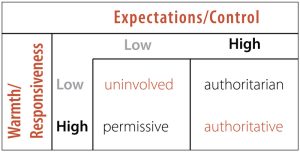
Examples of parenting style and parental mediation have found, in general, that those who are more permissive (higher in warmth over control) are less likely to restrict children’s screen time, while those who are more authoritarian are more likely to do so. In a 2009 study, Bumpass and Werner explored types of parental technology regulation. They studied 113 children in 3rd to 6th grades and 109 mothers, identifying four clusters based on rules, enforcement strategies, consequences, and child adjustment. Traditional mothers reported rules related to time, permission, and co-viewing. Technology-specific mothers used blocking software, filtering, and removal of privileges. Passive mothers voiced rules that required only minimal parental supervision, and they were more watchful of the child’s interest. And the children of parents with few rules (e.g., neglectful) reported slightly higher levels of internalizing problems such as depression and anxiety, and demonstrated slightly lower levels of prosocial behavior.
Wartella et al. (2013) found a parallel between parenting style and family media practices. Looking at families with children between birth to 8 years, those in mediacentric households (reporting approximately 11 hours or more per day) were more permissive than those who were media moderate or “media light.” Children in mediacentric homes are also more likely to have televisions in their bedrooms.
As demonstration of the complexity of applying the parenting style construct to the parent-child relationship with technology, a study of 504 parent-teen (12–17 year old) pairs proposed a model linking parenting style, online relational behaviors, and relational quality (Aloia & Warren, 2019). The researchers hypothesized that parental behaviors such as sending comforting messages and sharing material would mediate (i.e., be a conveyor for) parenting style and parent-child relationship quality including parent-child conflict and relational depth. In fact, although they validated previous research linking parenting style to relationship quality (e.g., enhanced parent-child conflict with authoritarian or permissive parenting), they found no relationship between parenting style, online relational behaviors by the parents, and relationship quality. Authoritarian parenting showed no relationship to any of the online strategies (comforting messages, material sharing, planning behaviors), and authoritative parenting showed positive and significant relationships to all three, yet permissive parenting also related significantly to two of the actions (comforting messages and material sharing). Planning behaviors and positive messages online were positively related to parental comfort, yet planning behaviors and material sharing were also related to perceived conflict. The authors observed methodological limitations (e.g., data from self-report) as a cause for the unexpected result, but also suggested that, with regard to mediated communication channels, parents and children may develop unique norms (p. 53). As Dworkin, et al. (2019) observe,
“The insurgence of technology has completely changed the family landscape, challenging what we know and requiring a reassessment of how we understand family relationships during adolescence, a time when technology acquires new meaning for developing and maintaining interpersonal relationships. (p. 514).”
Agency and Communion
Facilitating the child’s well-being related to technology through and while maintaining a positive relationship with the child is no small feat for parents. In promoting the child’s development, the relationship must be a balance of agency and communion by both individuals: assertion of the parent’s power while keeping in mind communion with the child; promotion of the child’s agency and independence, while keeping in mind the relationship. In promoting the child’s development, the relationship must be a balance of agency and communion by both individuals: assertion of the parent’s power while keeping in mind communion with the child; promotion of the child’s agency and independence, while keeping in mind the relationship. Unlike parenting style, which assesses the actions of the parent, perspectives of agency and communion regard both actors in the relationship (Heck & Pincus, 2001; Wiggins, 1991). Each person, in interaction with the other, asserts an action reflecting dimensions of both coordinates. Conflict arises when both are seeking agency (or power) more than communion. As related to parent-child relationships, conflicts occur with both child noncompliance and resistance to parents requests (high agency/low communion) and with parent resistance to children’s requests (high agency/low communion) (Eisenberg, 1992).
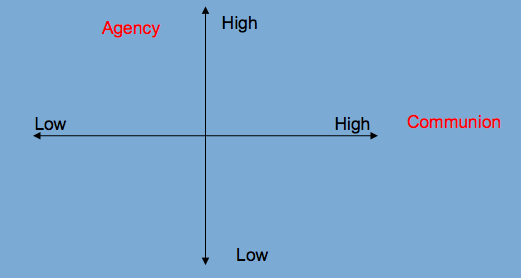
For example, if my partner and I are deciding on a vacation location, and I want to go to the mountains and they want to go to the beach, as we both assert our agency (power) in our desires, we compromise the value of communion (joint happiness). We are at a standstill and our relationship suffers. If, however, through discussion, we listen to each other about the interests of the other with a true value for the relationship and we come to compromise, we are more balanced in our individual agency and communion. Within the parent-child relationship, the parent’s actions are tempered by understanding the developmental age and ability of the child, and changes in that development over time (Heck & Pincus, 2001). Agency by the parent is, in part, a personal expression of fulfilling the responsibilities of childrearing. The joint balance of agency and communion between parent and child in negotiation and understanding is within this structure of safety and growth.
The ecological context is a consideration for both parent-child relationship models when applied to new media and digital technology. As observed in previous chapters, interactions and dynamics of the relationship are influenced by ecological contexts of the microsystem of the family, and by exosystems, macrosystems, and chronosystems. These systems create influences on the development of both the child and the parent, and on the conditions in which the family lives. Technology access and use and qualities of the devices and applications are external and inherent influences in each of the systems that can both facilitate and challenge relational dynamics (Navarro & Tudge, 2022; Lanigan, 2009).
Parental Mediation and the Parent-Child Relationship
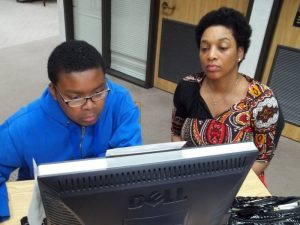
Fully 98% of parents in a recent U.S. study believe it is the parent’s responsibility to protect children from online content (Auxier et al., 2020), compared to 65% expecting the government or technology (78%) companies to bear responsibility. While most parents (71%) are aware of and concerned about the amount of time children 11 and younger are spending with screens (Auxier et al., 2020), more (84%) report feeling confident that they know how much screen time is too much. Most (71%) believe that widespread use of smartphones might be harmful to their children’s socioemotional learning. There is also concern by most about exposure to online predators (63%), sexually explicit content (60%), and violent content (59%). While bullying is a general concern of many parents, the majority (96% of parents of children 5–11) report that their child has not been bullied online (Auxier et al., 2020).
As parents assert their responsibilities to keep children safe online and guide their development, potential areas of conflict include:
- Parental attempts to regulate use.
- Parental concern over potentially negative consequences of internet use that can lead to over-restrictions on use.
- An imbalance of power as expertise in technology use varies between parent and child.
- Counter modeling of technology by parents’ own use (e.g., do as I say, not as I do)
- Parent invasion of children’s online social space.
The majority of families don’t perceive significant conflict around technology. Parents of young children (birth to age 8) don’t perceive regulating children’s technology use to be a conflict (Wartella et al., 2013). Even parents of older children (8 to 18 years) don’t report significant struggles. In a 2016 Commonsense Media report, nearly two-thirds of parents (62%) disagreed that getting a child to turn off their smartphone or tablet was a struggle. The majority (85%) agreed that monitoring child safety was important, and nearly the same amount (81%) disagreed that the child was less likely to communicate face-to-face. That said, parents of boys and of those children with lower grades did report greater struggle. Similarly, a 2018 report of families in the European Union also determined that most do not report conflict on technology use (Livingstone et al., 2015).
In large part, there is optimism that the lack of conflict observed in families is the result of technology oversight integrated into parenting practices and the parent-child relationship. Technology and adolescence researcher Candice Ogders (2018) observes,
Because online problems can be largely predicted by young people’s vulnerabilities offline, much of our existing knowledge about what promotes healthy child development is applicable even in what seems like a foreign digital landscape. Strategies such as the maintenance of supportive parent–child relationships that encourage disclosure, parental involvement in the activities of their children, and the avoidance of overly restrictive or coercive monitoring will help to support adolescents and keep them safe online, just as they do offline.
In the next section we explore types of mediation practices in families, and the potential for conflict, and the opportunities for parent-child communication.
Mediation practices
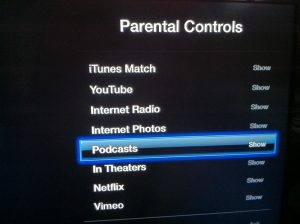
Mediation practices vary by type and family (Rudi & Dworkin, 2018). Frequently, mediation practices are labeled as active or “enabling” (of positive technology use) or restrictive. A recent qualitative study with 40 parents of Australian teens (Page, 2021) identified five mediation strategies, three of which were active: physical observation, digital surveillance, and trust-based and discursive strategies; one restrictive: restriction and control through social or technical means; and one (as alluded to in Chapter 6), indirect: talking with other parents. Parents’ active mediation occurs through direct parent-to-child interaction and conversation about media’s effects. Co-viewing or co-participation (such as playing games) enables parents to actively mediate and monitor children’s exposure and scaffold healthy use. More restrictive mediation means setting rules regarding the time spent or content viewed. It can also mean “e-rewards,” in which parents withhold or grant technology use in recognition of good behavior. More restrictive mediation means setting rules regarding the time spent or content viewed. It can also mean “e-rewards,” in which parents withhold or grant technology use in recognition of good behavior. Across the approaches, restrictive mediation can reduce negative media effects, and co-viewing or “enabling” can enhance or facilitate media’s positive effects (Coyne et al., 2017).
The EU Kids Online report (2020) surveyed children age 9–16 years in 19 countries. An average of 33% said their parents actively talk to them about the internet, 30% said sometimes, and 37% said never. Across countries, on average, higher percentages of children at younger ages reported parent discussion about the internet “at least sometimes:” 67% of 9–11 year olds, 61% of 12–14 year olds, and 54% of those 16 and older. When asked about active mediation strategies by parents, friends, and teachers, the highest percentages were reported for parents (e.g., 64% reported that parents “help me when something bothers me on the internet,” compared with 45% friends and 35% teachers). Internet safety is a common topic of mediation, with 85% of EU children reporting that their parents talk about this. More technical controls are far less frequently reported (22%, on average, report parental control through GPS monitoring, use of software that blocks or filters internet content, or tracking applications) . Also, a minority of children — about 15% — reported restrictions on using a web camera, downloading music, or using social media. That said, there are very clear differences in social media use restrictions by age, with the majority of children age 9–11 indicating that they cannot use social media.
The resolution of “conflict” with mediation is more nuanced than might be believed. Recent research with Australian families of teens revealed the range of ways that parents negotiating technology use with their teenagers (Page, 2021). Traditional mediation strategies may be used, but when they are not successful parents turn to other strategies, such as trust-based and discursive (reasoned negotiation) ones. Similarly, in interview research with pre-teen and teenage children (n=23) and their parents (n=18, Blackwell et al., 2016), children expressed the desire for shared expectations, rather than more attention to the issue of technology. They claimed that parents primarily told them what not to do, and didn’t have a very accurate perception of either the quantity or quality of their screen time, or its effects on them. The interviews unlocked a more complex dynamic than of parents establishing rules and children breaking them. They identified a give-and-take in negotiating family life, in which children’s needs and desires for technology use are taken into consideration, and reflect nuance — for example, when “rule violation” is acceptable. The authors concluded that families respect the developing teen’s need for privacy and independence, while maintaining consistent and realistic expectations around work, attention, and the interests of the whole family to better manage household technology use.
Influences on parental mediation
Age of child.
Parental restrictions on children’s technology use largely curve with the child’s age — with monitoring occurring through co-use in early childhood and middle childhood, then tapering off through adolescence.

Naab (2018) refers to early childhood parenting mediation as “trusteeship,” as the cognition and communication skill limitations of the very young child confer responsibilities on the parent to oversee their access and safe use as they make the transition to mediating children’s own active, independent use. Co-viewing with young children appears to be predominantly through traditional media including books, TV, smartphones, and tablets, and less so with games (Connell et al., 2015). As an indication of the blend of parental agency in the role and accommodating a child’s need, some parents may use media to soothe babies who are fussy and demonstrate poor self-regulation. Mediation with school age children can be restrictive (limiting use of hardware or software, including taking away technology as a punishment), monitoring (tracking use, messages, and the child’s location), and active (talking to children about their technology use) (Auxier et al., 2020; Blum-Ross et al., 2018; Livingstone et al., 2015).
Parents’ conversations with their children about the content of their media also varies by child age. In Commonsense Media’s 2016 study of parents and their teens and “tweens,” parents were more likely to talk with their 12–14 year olds about media content while watching television, viewing apps on a device, using a computer for something other than homework, and playing videogames than with their teenagers; only when it came to social media did parents report higher frequencies of discussing content with children. Coyne et al. (2017) observe that research has yet to determine the interplay between parents’ mediation strategies and more specific child characteristics.
Family demographic differences
Parents’ education, income, gender, and age may influence mediation. Parents who are higher in income and educational attainment and who demonstrate more comfort with technology may exercise more mediational practices. Livingstone et al. (2015) determined socioeconomic differences in mediation strategies and attitudes in a sample of parents of primarily 4- to 7-year-old children in seven countries, including England, Finland, and Russia. Families with less income, formal education, who are non-White, and whose parents measure higher on depression are more likely to report higher rates of media consumption. When surveyed, many parents note that media provides a safe, inexpensive, and available form of entertainment for their children (Livingstone et al., 2018). Similarly, Wartella et al.’s (2013) observation of permissive parenting style and mediacentrism, noted earlier, also showed demographic correlations. Parents who were lower-income and single reported greater consumption of media in the household than those with other demographic characteristics. Media was reported as a favorite family activity, and mothers were more likely to report using it as a parenting tool (e.g., keeping a child occupied and safe while she attended to other duties). It should be noted, however, that in a U.S. sample Connell et al. (2015) found scant relationships to co-viewing with young children by parent education level or race. Parents in the EU with more education and income used a diversity of mediation strategies and encouraged non-school media use for learning. Cross national variation in parent mediation strategies has been found among the Finnish (actively engaged), Czech (passive), and in EU and UK countries and Russia (restrictive) (Helsper et al., 2013).
Mothers are more likely to demonstrate mediation than fathers (Connell et al., 2015; CSM, 2016). In their research among Portuguese school-age children, Ferreira et al. (2017) identified not only parent gender differences in mediation by type of activity (e.g., fathers actively mediating children’s use while playing videogames), but gendered perspectives by children of parents’ technology mediation. Children perceived fathers as more skilled in using technology, reported that their technology was for work (vs. mothers’ devices that were to be shared), and that the father’s mediation was more technical (e.g., uploading, removing software) and mother’s more digital (e.g., exposure to content quality).
Parents’ technology use, comfort, and skill
Parents’ mediation strategies appear to relate to their attitudes toward technology, their competencies, and their own use, as observed in research in EU countries (Brito et al., 2017; Livingstone et al., 2018) and research in the US (e.g., Commonsense Media, 2016; Wartella et al., 2013). Observing the construct of reasoned action applied to technology acceptance (Ajzen, 1985), Nikken and Opree’s (2018) survey of parents of young children (ages 1–9) in the Netherlands identified basic proficiency associated with the ease of active co-use. Advanced and basic proficiency with technology related to restrictive mediation, and advanced proficiency related to imposing technical restrictions. As Naab (2018) observed from in depth interviews with 29 parents of young children, parents are often uncertain about digital strategies and gain proficiency over time through interaction with their child, acquisition of knowledge about technology’s affordances and challenges, and their own comfort with the interplay between themselves and their child’s needs. Parents are often uncertain about digital strategies and gain proficiency over time through interaction with their child, acquisition of knowledge about technology’s affordances and challenges, and their own comfort with the interplay between themselves and their child’s needs.
Parental use can influence the effectiveness of their mediation strategies. In the Commonsense Media study with over 1100 parents in 2016, parents spend more than 9 hours a day with screen media (especially personal media like smartphones) . A majority (78%) believe they are good media and technology models for their children. Yet research with parent-teen pairs indicates that when teens see parents’ time on their phones similar to their own, they question parental advice and role modeling (Commonsense Media, 2016; Livingstone et al., 2018).
Child guidance and the power differential
Children are challenged when their parents are ‘all thumbs’ with using technology.
https://youtu.be/A6A331B1oq8
The picture of parental mediation can get complicated as a generation of children grow up with technology in ways far different than those of their parents, and a potential power dynamic is shifted. Livingstone et al. 2018 observe this particularly in lower-income and immigrant homes, as children gain more comfort and skill with technology than their parents (Livingstone et al., 2018), or when children need to assist parents with language translation and technology. Perhaps this is why teens don’t turn to parents for safety issues related to technology (Blum-Ross et al., 2018; Commonsense Media, 2018), or for information on sexual health. Flores and Barroso (2018) identified SES differences in parental technology comfort and use and the ability to talk to their teenagers about sex. Limited knowledge of how technology works, including realities of peer communication, privacy issues and laws, and the potential for exposure to imagery, act as barriers to parental communication that supports the child’s sexual health.
Various scholars have characterized this complicated parent-child power dynamic (Dworkin et al., 2019). Livingstone across 19 countries, on average 40% of 9–16-year-olds report often or very often helping parents when they found something difficult online, and 29% sometimes helping parents. This differential in knowledge can upset the traditional family hierarchy. (2009) refers to tech-knowledgeable children in the household as “youthful experts,” while Katz (2010) calls them ‘media brokers.’ Correa (2014) labels the knowledge sharing as “bottom-up technology transmission,” and the EU Kids on the Internet 2020 report calls this “reverse mediation.” The latter reports that, across 19 countries, on average 40% of 9–16-year-olds report often or very often helping parents when they found something difficult online, and 29% sometimes helping parents. This differential in knowledge can upset the traditional family hierarchy. In interviews with parent-teen pairs in 1995, Kiesler et al. (2000) determined that fathers’ attitudes prevented them from seeking help from their children about internet-related issues; the fathers voiced concern about a shift in their parental authority.
In a later study with Belgian parents and teens, Nelissen and Van den Bulck (2017) predicted that reports of conflict would correlate with parental requests for assistance with technology. The survey included questions like “Do you ever get into an argument with your child/with your parent about (a) television use, (b) tablet use, (c) smartphone use, or (d) computer/laptop use?” It used a 5-point Likert scale ranging from “(almost) never” (=0) to “(almost) always” (=4). With regard to media guidance, the pairs were asked “If you think about your children, how often do they teach you to use the following media, technologies, and/or applications?/If you think about your parents, how often do you teach them to use the following media, technologies, and/or applications?” Again, a 5-point Likert scale was used and applied to 13 technologiesm including smartphones, online purchases, and tablets. After controlling for demographic variables (including parent and child gender and age), there were significant associations between a parent help seeking/guidance by children and parent-child conflict. The authors observed that child guidance was dominant on some technologies — smartphones and specific apps — but not all.
An example of context as influence on parental mediation: The COVID-19 pandemic
When conditions encourage children’s technology use, parental mediation can shift. Clearly, the COVID-19 pandemic was an influence. As their children connected with friends, attended school, and sought out hobbies online during isolation and quarantine, parents’ efforts to mediate children’s screen time changed. As a report by Pew (2021) indicates, fewer parents reduced children’s time on screens and took away children’s smartphone privileges. On the other hand, more parents were active in checking children’s exposure online, and parents’ beliefs that their children spent too much time online nearly doubled. Among parents of children 11 or younger, in 2020, 28% felt their children spent too much time on their phones. In 2021, that percentage climbed to 42%. (See figure below).
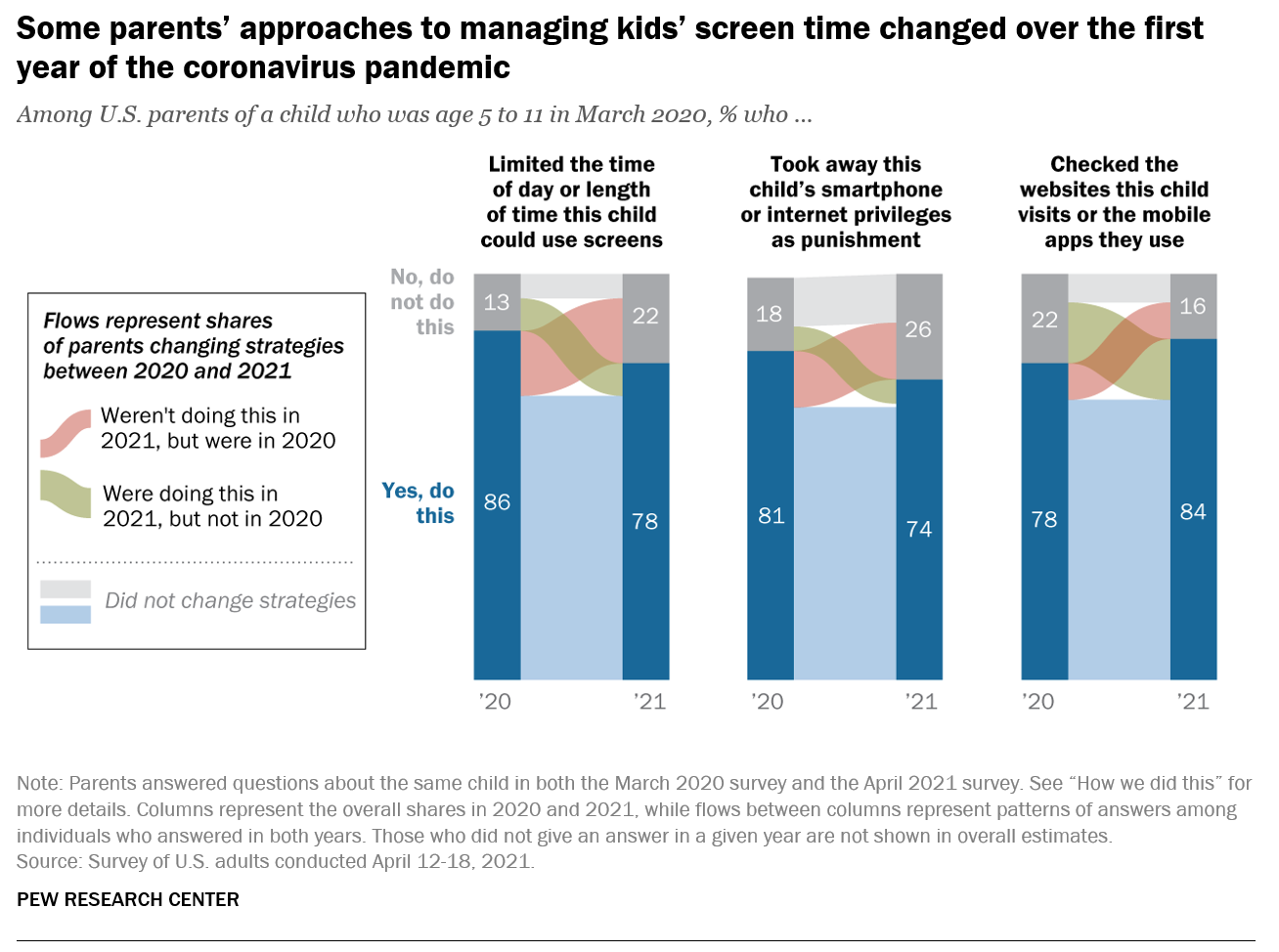
With regard to older children, parents reported that, during COVID, connections through videoconferencing, and with resident children through gaming and time spent together, deepened personal relationships (Joyce et al., 2021).
Technology’s Role in Parent-Child Communication
The primary reason that parents secure phones for their children, even before age 12, is to communicate with them (Auxier et al., 2020). Through texting and through voice and video calls, parents can convey information to children that supports their development, enable coordination, and promote closeness. The efficiency of using ICT for communication also makes co-parenting relationships easier, such in the case of divorced and separated parents (Ganong et al., 2012; Saini & Pollack, 2018), and maintains parent-child connections during separations, including military deployment (Carter & Renshaw, 2016) and immigration (Casmiro & Nico, 2016; Karraker, 2015).
Shin et al.’s (2021) literature review on technology designs that foster the parent-child relationship identified factors indicative of family qualities and technology-specific conditions. They include:
- reciprocity in the family,
- reinforcement of transparency,
- affection and trust,
- physical proxy of each other through an object or interface design,
- accessibility, level of technology sophistication and communication resource, and
- enjoyable, age-appropriate shared content between parents and children, and situational awareness and routine.

When parents and children are at a distance, system design that favors media richness (closer approximation of real life) and synchronicity, and the ability to maintain privacy, are positive. Challenges to the parent-child relationship occur through discrepancies in expected communication between parent and child(ren), through parents’ complex emotions toward parenting due to their busy schedule, and, from the technological standpoint, from access limitations. As this section of the chapter indicates, the use of technology as a means to facilitate parent-child relationships is quite a complex issue. Although there are elements specific to digital media and the programming of the for communication and interaction, challenges arise through human factors inherent in the individuals and their relationships.
Connections, for example, may not always be smooth, and whether due to technology or the actor, complications can arise. Use of technology to maintain the parent-child relationship may lead to what Parrenas and Boris (2010, as cited by Karraker, 2015 p. 13) refer to as the “antithesis of intimacy.” Expectations for maintaining communication through the ease afforded by digital media can impinge on children’s or parents’ independence. Connections, for example, may not always be smooth, and whether due to technology or the actor, complications can arise. The complicated power dynamics discussed above can and do interfere with satisfaction when using technology for parent-child communications. And although teleconferencing made parent-child visits possible during COVID-19 for those facing separation due to welfare issues, technological and human barriers prevented this alternative to in-person visits from being successful (Goldberg et al., 2021).
Shin et al. (2021) observe developmental differences reflected in the availability of technology and use by parents and children that affect satisfaction. For young children, technology that is playful, age-appropriate, and encourages creativity can foster engagement by both parent and child. School-age children and their parents have a strong desire to be together, learn more about each other, and feel a sense of warmth and security. Yet designs may not be user- or communication-friendly, and differences in ability and access can create barriers to effective use. For older children (e.g., adolescents), when parents and teens have access to phones and social media, and when a common time for interaction is apparent, communication appears effective. Yet as Dworkin et al. (2019) observe, the paradox of connecting and distancing can make parents’ use of social networking and unscheduled calls feel intrusive and like a privacy invasio.
Assets and challenges are apparent for specific populations of parents and children as well. Parents and children attempting to maintain communication through technology across legal separations face particular scrutiny with regard to child privacy and safety (Saini & Pollack, 2018). In a survey with 106 family caseworkers, Saini and Pollack (2018) identified that the majority of legally separated parents and children use technology to maintain communication. This can be quite positive, as they can each keep abreast of the life details of the other and maintain connectedness, particularly when a child is long-distance and living in the other parent’s home or in a foster home. Caseworkers also saw it as a way to protect the child from conflict in the parent-to-parent relationship, and enhance the child’s feeling of safety. Yet rampant posting on social media diminishes the child’s safety, as well as the privacy of the parent who may closely monitor and track the child. As with other cases representing the range of technologies’ uses and affordances, the picture is a complex one. Because of this, the caseworkers in Saini and Pollack’s study advocates for ICT not as a replacement for parent-child connections, but as a way to enhance communication.
Possible disruption in the relationship: Parents’ own technology use

As noted above, parents’ own technology use is a significant factor in their attitudes about monitoring and mediating children’s use, and in shaping and modeling children’s technology consumption. Samual’s (2017) counter response to the argument that smartphones were destroying a generation (Twenge, 2017) was that smartphones distracted parents, leading them to demonstrate “minimal parenting.” McDaniel’s (2019) and Kildare and Middlemiss’ (2017) reviews of the literature concerning parents’ use of technology when with their children paint a third picture of communication in the relationship: that of nonverbal messaging through distracted use. Noting that the majority of research in this area has focused on parents of young children, McDaniel observes the many reasons parents would use their phones with a child present. Not only do they seek information and communicate with others, seek emotional support, or continue work, but their use attempts to relieve the boredom of childrearing. This “ technoference ” (McDaniel’s term for the “everyday intrusions and interruptions of devices in our face-to-face interactions”) can have potentially serious consequences to the child through the parents’ ability to connect and engage and through the child’s own observation of the parent’s distracted action, and can negatively impact the parent’s own emotional state. Parenting outcomes of being distracted by one’s phone include reduced verbal and nonverbal interactions with the child, reduced awareness and sensitivity to the child’s needs and responses, and reduced coordination and communication in co-parenting. McDaniel, and Kildare and Middlemiss, note that these responses are directly associated with the relational mechanisms in attachment formation, although longitudinal research to date hasn’t validated these assumptions.
Additional parenting consequences of being distracted by technology include the difficulty of multitasking between the device and the needs and attention of the child, and time displacement (e.g., focusing on a phone compared to active time with a child). From the child’s perspective, they may express dissatisfaction in the time spent with the parent and in turn, feel ignored. Kildare and Middlemiss cite a study in which 32% (of 6,000) children reported feeling unimportant when their parents were distracted by a phone. As the authors of both review articles observe, more research is needed to more definitively understand specific dimensions of parental technology use with children (e.g., how much time is spent on phones when with children, specific activities parents do while on their phones) and impacts on parenting, the relationship, and child development. They also observe that it’s not reasonable to expect parents not to engage with technology when with their children, observing the complex reasons that parents use technology. They advocate for education on appropriate use, and engagement in ways that are healthy for the relationship and for the child. This resource from Zero to Three offers parents ways to focus on their children, not their phones.
“Sharenting”
As discussed in Chapter 6, parents express their caregiver and relational identities online through blogging, posting on social media, and texting ideas and images of the children to others (Blum-Ross & Livingstone, 2017). A challenge can occur in the parent-child relationship when children object to their images and information about themselves being shared, particularly without permission ( Saner (2018 ) refers to this as a “permanent digital tattoo”). While not as overt an expression of distraction by technology use as those discussed above, “sharenting” can still send a message to the child that their feelings are not being considered. Blum-Ross and Livingstone (2017) determined that when parents of younger children share images and experiences of their child and childrearing, they may also have misgivings about the archival nature of the internet and the possibility of their posts resurfacing when the child is older. Parents also express a certain element of guilt, part of the complex feelings parents describe, as discovered in Shin et al. (2022)’s review of the literature of parent-child relationships through technological innovation. Parents hold an awareness of the child’s aging to the point of awareness and expressing feelings of dissatisfaction with their private information being shared. Blum-Ross and Livingstone share this incident, which directly points to the potential conflict with “sharenting” and the need for parent-child communication to maintain communion:
Harvey confronted this issue when his 6-year-old son Archie began to express discomfort at appearing on the blog. Harvey described how Archie had begun to ask what the photos Harvey took were for, questioning “is this a photo for you, Daddy, or is it a photo for the blog”’ Increasingly Archie would refuse to be in pictures, eventually exacting revenge by covertly using Harvey’s phone to post an unflattering picture of Harvey eating a sandwich on his dad’s Instagram feed. Harvey was working with Archie to help Archie decide what “he wants me to write” so he could be more in control. Yet, finding himself cajoling his son, Harvey described a struggle between respecting his son’s boundaries and keeping his commitment to the blog and his readership among the wider blogging community. (Blum-Ross & Livingstone, 2017, p. 116).
Focus on technology-facilitated parent-child relationships in young adulthood
A significant amount of research has examined the role of technology in the parent-child relationship during young adulthood. One conclusion is that the availability and use of ICT is a positive influence on this relationship. A review by Hessel and Dworkin (2018) identified differences in how young adults use technology to communicate with parents, compared with siblings and grandparents. The authors indicated that when children go to college (given that college students are an often sampled group in this research area), there may be a stronger focus on the relationship, and technology has an intentional purpose. While they indicate that the research on persons other than parents is limited, young adults appear to use a variety of methods to maintain relationships with parents through technology, including adding parents as “friend”’ on social media, texting, and sending email (though the Hessel and Dworkin review and McCurdy et al.’s 2022 research with college students validates that email use has declined). Purposes include utility (sharing, asking for help), immediacy, and emotional connections. Relationship quality appears to be positive, as demonstrated by emerging adults’ reports of satisfaction, feelings of intimacy, and the number of types of media used for communication.
As an example, Vaterlaus et al. (2019), surveyed 766 young adults and adolescents (just over 10% of the sample) Young adults’ reports of using computer-mediated communication with parents (particularly text messaging when it came to both mothers and fathers) were significantly associated with feelings of closeness, togetherness, and connection in their time spent with the parent. and their parents on their use of technology together and on the notions of quantity and quality time spent. Not surprisingly (given that the young adults were away and in college), teens reported spending more time with their parents. Among the whole sample, there was a clear perceptual difference between quantity time and quality time. Young adults still sought and identified having quality time with parents. Type of media was differentiated when considering connectivity: synchronous media such as telephone calls, video chat, and texting facilitated quality interactions; fewer young adults reported using email, social networking, and texting for quality interactions. And young adults’ reports of using computer-mediated communication with parents (particularly text messaging when it came to both mothers and fathers) were significantly associated with feelings of closeness, togetherness, and connection in their time spent with the parent. The authors observe the role that technology can play in maintaining quality relationships between parents and teens, and acknowledge the challenges brought about through an individual being distracted by media when in the presence of the other. They recommend additional research and educational efforts on the benefits of using technology together in ways that foster and facilitate relationships.
Yet Hessel and Dworkin indicate that a dominant theme in the literature indicates potential challenges with autonomy, or rather the lack thereof. Frequency of contact with parents and parental over-involvement related to lower feelings of autonomy, whereas those with a strong parent-child relationship reported higher levels of autonomy. They also observe that, as noted in Chapter 5, there are differences by generational cohort, as research with college students just two years apart indicates differences in email and social networking behavior with parents.

McCurdy et al. (2022) also point to differences in communication behavior and perceived young adult/parent relationships. In interviews with 44 college students, those who used a rich communication repertoire for connection with their parents reported more closeness. Citing media multiplexity theory, the authors identified that students perceived stronger relationships due to multiple technologies affording more contact frequency, more ways to make connection, and a stronger parental social presence. Interestingly, young adults also were strategic about differentials in technology competence and access by their parents to maintain boundaries. Knowing what skills their parents had, and which applications they did and didn’t use, worked to their advantage as ways to find necessary separation for their individuation. From Miller-Ott et al.’s (2014) research, frequent texting, establishing rules around availability, repetitive contact, and relational arguments were more direct strategies for healthy individuation with connectedness.
Research also suggests new opportunities for connecting with parents: gaming, social media, video creation, even family genealogy applications. Given the range of potential technologies for interaction and differentials in access and use together, Hessel and Dworkin (2018, p. 369) wisely observe,
Rather than building research around specific technology, such as Facebook, categorizing technology options by context will produce findings that are more transferable and durable. Using theoretical foundations such as Media Richness Theory may help to identify which technology choices complement which types of communication between which family members for what purpose.
This chapter reveals complexities in the notion of the parent-child relationship and technology. Most families don’t perceive conflict, though when the focus of research, perception may be skewed depending on who is being interviewed. Positively, many children and parents manage negotiations around children’s healthy technology use, and parents practice active or other types of mediation that encourage children’s positive use. many children and parents constructively negotiate healthy technology use, and parents practice active or other types of mediation that are encouraging and maintain trust and communication in the relationship There isn’t a need for practices that are restrictive or punitive. Active mediation strategies align with a life-course model of relationships and developmental growth that balances a respect for each individual’s ability for agency and for the communion of the relationship.
The chapter also examined the many factors that can influence the ways parents’ mediate, which can contribute to conflict or to the lack thereof. Key within these is the generational difference in parents’ own knowledge and use of technology. When children grow up knowing more, and “reverse mediation” occurs, the power dynamic can shift. In some homes, this can be sensitive. The dynamic shifts as well when parents’ technology use leads to their being distracted from their children. This sends a strong non-verbal message about the importance of the relationship, and can have damaging effects on parenting, on the relationship, and consequently on child development. As technology continues to evolve, and as generations of children and parents change in their knowledge, skills, comfort, and expectations about using technology individually and with each other, the clear message for both parents and children is one of intentionality.
As technology continues to evolve, and as generations of children and parents change in their knowledge, skills, comfort, and expectations about using technology individually and with each other, the clear message for both parents and children is one of intentionality. Shin et al. (2021) advocate for a life-course perspective in the future design of technology to promote the parent-child relationship:
Technology design that supports relationships must be responsive to the dynamic environment and transactional nature of relationships; accordingly, designers should be aware of technology’s role, and find ways to provide users with timely suggestions. The family life course development approach provides a theoretical lens by which design can incorporate a family’s transactional nature. The theory’s central assumption is that the family’s developmental process is inevitable, and that individuals’ lives change dynamically over time. It further explains how the lives of individual family members, such as parents and children, are interconnected, and how families transmit their assets and disadvantages to the next generation. [p.441:22]
For parents, technology visionary and parent danah boyd suggests approaching technology with an attitude of flexibility (Tippet, 2017):
From my perspective, it’s about stepping back and not assuming that just the technology is transformative, and saying, okay, what are we trying to achieve here? What does balance look like? What does happiness look like? What does success look like? What are these core tenets or values that we’re aiming for, and how do we achieve them holistically across our lives? And certainly, when parents are navigating this, I think one of the difficulties is to recognize that this is what your values are, and they may be different from your child’s values. And so how do you learn to sit and have a conversation of “Here’s what I want for you. What do you want? And how do we balance that?” And that’s that negotiation that’s really hard. And so I think about it in terms of all of us — how do you find your own sense of grounding?
- The volume of research on parenting styles should motivate readers interested in this concept and in parent-child relationships and technology to seek out specific, current, and cross-cultural/cultural literature. ↵
Critical Perspectives on Technology and the Family Copyright © 2022 by Susan K. Walker is licensed under a Creative Commons Attribution-NonCommercial 4.0 International License , except where otherwise noted.
Share This Book
Articles on Parent-child relationships
Displaying all articles.

How having conversations with children builds their language — and strengthens family connections
Kimberly Hillier , University of Windsor

‘Mum, can you play with me?’ It’s important to play with your kids but let them make the rules
Victoria Whitington , University of South Australia

Meditative mothering? How Buddhism honors both compassionate caregiving and celibate monks and nuns
Liz Wilson , Miami University

Time to abolish the Canadian law that allows adults to spank and hit children
Tracie O. Afifi , University of Manitoba and Andrea Gonzalez , McMaster University

How parents feel about feelings can deeply affect a child’s development
Gillian England-Mason , University of Calgary

My child isn’t happy with their final exam results. How can I support them?
Nicolette V Roman , University of the Western Cape

Better sleep for kids starts with better sleep for parents – especially after holiday disruptions to routines
Erika Bocknek , Wayne State University

Give the gift of presence and love during the holidays
Nikki Martyn , University of Guelph-Humber

Talking with your teen about high school helps them open up about big (and little) things in their lives
Lindsey Jaber , University of Windsor
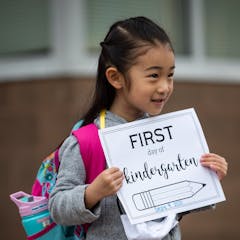
Kindergarten transitions can be eased by supporting kids’ social and emotional needs

Parenting styles vary across the US
Cliff McKinney , Mississippi State University

Is March Break really a break? How pandemic-weary parents can recharge and connect with children without a vacation
Kimberly Hillier , University of Windsor and Lindsey Jaber , University of Windsor

5 tips for a safe Halloween during COVID-19 — and what to do if trick-or -treating is cancelled
Sheri Madigan , University of Calgary ; Craig Jenne , University of Calgary , and Rachel Eirich , University of Calgary

To safeguard children’s mental health during COVID-19 , parents must look after their own
Sarah Whittle , The University of Melbourne and Kate Bray , The University of Melbourne
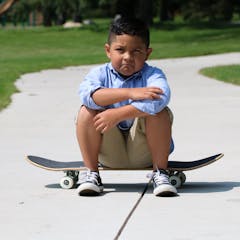
Children’s grief in coronavirus quarantine may look like anger. Here’s how parents can respond
Elena Merenda , University of Guelph-Humber and Nikki Martyn , University of Guelph-Humber

Fun with rhymes and word play helps children learn to read
Aviva Segal , Concordia University and Sandra Martin-Chang , Concordia University
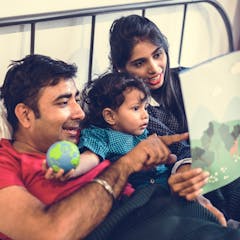
Parents play a key role in fostering children’s love of reading
Lorraine Reggin , University of Calgary ; Penny Pexman , University of Calgary ; Sheri Madigan , University of Calgary , and Susan Graham , University of Calgary

How to get kids talking about their school day
Jessica Cooke , University of Calgary and Sheri Madigan , University of Calgary

Hospitals must adapt so infants can ‘ room-in ’ with opioid-dependent mothers
Mary Malebranche , University of Calgary
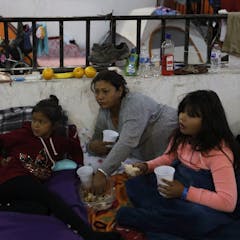
The challenge of parenting in a migrant caravan
Dillon Thomas Browne , University of Waterloo
Related Topics
- Child development
- Early childhood education
- Family relationships
- Listen to this article
- Parent-child communication
Top contributors
Professor, Canada Research Chair in Determinants of Child Development, Owerko Centre at the Alberta Children’s Hospital Research Institute, University of Calgary
Instructor, Faculty of Education, University of Windsor
Assistant Professor of Educational Psychology, Faculty of Education, University of Windsor
Program Head of Early Childhood Studies, University of Guelph-Humber
SARChI: Human Capabilities, Social Cohesion and the Family, University of the Western Cape
PhD candidate, University of Calgary
Clinical Lecturer, University of Calgary
Professor of Psychology, Western University
PhD Student, Department of Psychology, University of Calgary
Associate Professor of Educational Psychology, Wayne State University
Professor of Psychiatry, The University of Melbourne
Professor, Department of Psychology, University of Calgary
Part-time faculty, Department of Education, Concordia University; Postdoctoral fellow, Centre for Research on Children and Families (CRCF), McGill University, Concordia University
Professor, Department of Education, Concordia University
PhD Candidate, The University of Melbourne
- X (Twitter)
- Unfollow topic Follow topic
An official website of the United States government
The .gov means it’s official. Federal government websites often end in .gov or .mil. Before sharing sensitive information, make sure you’re on a federal government site.
The site is secure. The https:// ensures that you are connecting to the official website and that any information you provide is encrypted and transmitted securely.
- Publications
- Account settings
Preview improvements coming to the PMC website in October 2024. Learn More or Try it out now .
- Advanced Search
- Journal List
- v.14(10); 2022 Oct

The Effect of Parenting and the Parent-Child Relationship on a Child's Cognitive Development: A Literature Review
Purva d lanjekar.
1 Community Medicine, Jawaharlal Nehru Medical College, Datta Meghe Institute of Medical Sciences, Wardha, IND
Shiv H Joshi
Puja d lanjekar, vasant wagh.
Various studies have been done on subjects such as parenting, parent-child relationships, parenting style, effortful parenting, the concept of parenting, the cognitive development of children, and the cognition of parents. This research is mainly based on parenting practice, child development, and maturation. Children's cognitive development starts in the first year of life and then progresses gradually. Children require positive parenting in painful and different situations. Parenting gives a child the confidence to face crucial, challenging problems. Sensitive parenting and caregiving are required for the child's maturity and cognitive development. Media has been observed to be essential in improving parenting practices. Children exhibit internalizing and externalizing symptoms as a result of harsh, aggressive, and intrusive parenting. According to the data, it is seen that the risk of depression increases in adolescence. The main reason for the rise in depression in children is the non-cooperation and support of mothers and fathers. The risk of depression decreases in children whose mothers and fathers are cooperative and supportive. While family and social stress increase the chances of depression in children, a negative parenting style means children face family and social anxiety. Due to the high level of hostile parenting and low level of positive parenting, they experience stress, peer pressure, and social and family relationship problems. Another excellent term for effortful control parenting is required for children's cognitive development. Parenting is necessary for the regulation of emotions and behavior. There are many problems seen in infancy, early childhood, and late childhood. There are four types of parenting styles seen: authoritative parenting, authoritarian parenting/controlling parenting, permissive parenting/indulgent parenting, and uninvolved parenting/neglecting to parent. Good parenting requires one to know the concept of good parenting, the idea of parenting, the importance of parenting and children's needs, the components of parenting, and the consequences of parenting.
Introduction and background
Good parenting is a process whereby a parent meets a child's needs according to the cultural standard that changes from generation to generation [ 1 ]. Research on parent-child relationships and childhood development increased rapidly during this era; the research is mainly based on parenting practices and child development and maturation. Many studies show that mental and physical stimuli like cognition development, language, social emotion, and children's motor skills in infants and children are very hard to mature or grow. Higher academic performance, income, and socioeconomic development decide childhood growth [ 2 - 5 ]. Parenting is the process of supporting and promoting a child's physical, emotional, mental, and social development. Quality of instructions, animation, cognitive stimulation, physical care, parent-child synchrony, sensitivity, and positive responsiveness are dimensions of parenting and are interrelated with the child's cognitive development. Mainly, research focuses on increasing parental support and responsibility to develop children's cognitive abilities, thus providing sensitive caregiving effects on children's cognitive development. Parenting offers support and care to the child in painful or stressful situations and gives confidence when the child is in non-distressing or non-stressful conditions. Sensitive parenting with young children provides an emotional climate for them. Supporting and sensitive parenting offers children security and confidence; parents promote reasonable regulations and self-initiation in social and non-social experiments. Self-sufficient support and sensitivity, caregiving nature, such as best emotions, lead to early brain maturation and cognitive development in children. Sensitive parenting shows affective and behavioral development in children; it is characterized by responsiveness, positive encouragement for something, giving approval or thanking, stimulation, and lingering [ 6 - 8 ]. Children's health, behavior, development, and style of parenting are always a cause of worry for every parent. In such cases, professional help is required to solve this problem. It is related to family care, youth and parenting support, and children's mental health. The media is exclusively used to increase parenting information and awareness. It enhances parenting skills and decreases depression, anxiety, and stress; it also helps the parents improve the skills of the parent-child relationship and supports them for the benefit of the child's health and well-being [ 3 - 5 , 9 ]. This research is primarily focused on parenting styles, child cognition, and the concept of parenting.
Methodology
We searched the PubMed and Google Scholar databases for articles. We identified articles by using words like "parenting style," "child cognition," "parent cognition," "cognitive development," and "parenting." We got 265 results after our search. Out of 265 results, the articles lacking parenting and cognition were excluded. Additional relevant references from these articles were also reviewed.
Parenting and cognition
Zvara BJ et al. [ 10 ] observed that for a child to mature, a facilitative environment is required. Children's emotional regulation starts developing in the first year of life and rapidly develops in the coming years. The current and later ways of acting at school age are predicted by the emotional regulations in the preschool period. Children may not develop strong relationships with friends if their mother or father has difficulties regulating their own emotions in front of the children. It is seen that fearful, inhibited boys are affected by sensitive parenting. In contrast, girls with less self-control and fear are not affected by sensitive parenting [ 11 ]. Children develop and regulate their emotions when their parents are sensitive and supportive of them. At the same time, it is seen that a greater level of internalizing symptoms like sadness, anxiety, and loneliness, and externalizing symptoms like overreacting, poor impulse control, non-compliance, aggression, and poor relationships with friends are seen in children who do not get proper parenting. It was also noticed that internalizing and externalizing symptoms and problematic peer relationships are associated with harsh, aggressive, or intrusive parenting [ 10 ]. Parents play an important role in depression. The risk of depression increases when children's relationships with their mother and father are non-cooperative and lacking support. At the same time, the risk of depression decreases when children's relationships with parents are supportive and collaborative, which is the hallmark of positive parenting. Many studies show that parenting behavior can cause depression. Studies show that youngsters with less warmth, compliance, acceptance or a high level of rejection and criticism from parents develop a poor self-image and negative cognitive style [ 12 , 13 ]. A self-report questionnaire to examine whether a low level of positive parenting contributes to depression via a cognitive vulnerability, including a negative cognitive style, is used. The self-report provides useful, complementary information about parenting behavior. It is seen that positive parenting protects against emotional reactivity and peer pressure but not from non-peer pressure like health, finance, academic, and family problems. At the same time, the adverse events among anxious youth across the transition are limited due to the low positive relationships with parents [ 13 , 14 ]. Recent studies show that it is unclear if family and social stress also cause depression in youngsters. It is also found that negative cognitive style among children, peer stress, and family stress among youngsters are due to the high level of hostile/negative parenting. According to this, it is seen that the maturation of cognitive interpretation in response to social, family, and peer stress during adolescence is resolved by interactive relationships between parents and children. Younger individuals experience stress and peer pressure as well as family stress as a result of low levels of positive parenting and a high level of hostile parenting; this child presents with a negative cognitive style, cognitive vulnerability, depressive symptoms, and depressive episodes. Another type of stress is social stress; it is also due to low levels of positive parenting and a high level of hostile parenting [ 13 , 15 ].
Effortful parenting and control
Positive parenting and effortful control of children are necessary for child cognitive development. Effortful control means suppressing the dominant response to perform the subdominant response. It includes inhibitory control, attention, focusing, and attention shifting. At the same time, components are the ability to initiate or suppress behavior. In children, the self-regulating ability is seen between six and 12 months of age and rises in preschool. Effortful control is also required for children's emotions and behavior regulations [ 16 , 17 ]. This study observed that children who are less able to focus in academic years or socially due to harsh and non-supportive parenting. Due to warm and supportive parenting, a child can regulate their emotions, and they become less frustrated and angry. The ability to initiate or suppress behavior is the central part of effortful control and is related to externalizing problems mainly after 4.5 years of age. Children's external problems are directly proportional to low levels of effortful control. Supportive parenting is linked with early adolescence for self-control and difficult adjustment, while school achievement in children is linked with external behavior and effortful control [ 16 - 18 ]. Much of the research focuses only on the mother-child relationship and not on the role of fathers in parenting. Studies show that fathers also spend time with children, and that time increases gradually. The interaction of the child with the father and mother has differed; the father is always like a friend to the child, while the mother is a caregiver to the child. Fathers encourage the child for emotional stimulation, to solve problems, and to go to the outside world for development and exposure [ 19 ]. Hence, the father also plays an essential role in the maturation of exclusive function or condition. While the mother is more related to emotion, she is the source of comfort in stressful stimulation. Maternal parenting is more important; it is associated with the child's effortful control of both current and future stimulation and emotions because the mother uses a positive emotional tone for parenting; therefore, for effortful control of children, positive parenting is necessary. Low levels of effortful control in the child are associated with parental rejection and inconsistency. If parents make positive changes in parenting, then children will demonstrate early learning skills and less problematic behavior. Effortful control affects positive parenting at a younger age for children. At the same time, parenting affects the effortful control of an older generation's life. Hence, it is observed that both paternal and maternal parenting are essential for effortful control and child development [ 16 , 20 ].
Children's cognitive development
Table Table1 shows 1 shows the stages of cognitive development.
According to Piaget's classification, the pre-operational stage is the stage between the ages of two and seven. At this age, children's maturation is a genuinely logical operation. Operation means pliable actions that can interact with each other to solve problems. According to the Piaget theory of cognitive development, older children have more flexible logical operations, while in young children, judgment is dominated by perceptual appearance. According to Muller, children between five and six years of age are surprised to see any weird situation; this is called the primitive identity concept. The primitive idea is the primary milestone. It gives the child reason to think about their gender identity [ 22 , 23 ]. Representational thought is the ability of a child to form mental symbols to represent an object or event that is not present. At the age of two, a child is in the transductive reasoning stage, which means children are influenced by their desires. Children are befuddled by experience and it is difficult for them to remain satisfied with their current way of thinking. Egocentrism in children is the inability to take other points of view. It is not selfless. Instead, it is referred to as "intellectual limitations" [ 22 , 23 ].
Problem and accommodation difficulty during infancy, early childhood, and late childhood
Infancy is a time when parents and children adjust quickly to each other for effortful development. In the first year of life, they face feeding problems, digestive discomfort from colic, vomiting, constipation, diarrhea, irregular sleep patterns, and crying. Witnessing the quarrels between mother and father during the baby's physical and mental growth period makes them hostile and unrestrained in the second year of life. Parents report that their child's behavior at this age is stubborn and they have a temper. An infant with autism fails to focus on people's eyes, doesn't show affection when parents leave them, and shows less social interaction. In such cases, children become ignorant, misused, and poorly stimulated [ 22 , 24 ].
Early Childhood
Children in preschool have mobility problems, language-related problems, and immature judgment. Studies and surveys show that a common problem in preschool children is due to representational thinking and fear involving thought and imagination. Other issues are being asocial; using physical and verbal power; being overactive, talkative, angry, whining, showing off, arguing with others, demanding attention, disobedience, and resisting bedtime [ 22 , 24 ].
Late Childhood
A child's experiences in school can determine if he/she "fits in" academically and socially. Some children feel uncomfortable due to low socioeconomic status, casteism, and comparison with friends regarding academic and social matters, leading to mental retardation, physiological disorder, and intellectual problems. The most common problems in this age group are arguing with others, showing off, being talkative, and being self-conscious (most common). School phobia is normal anxiety about school, and it is due to a fear of separation from parents. An internalizing problem pattern is defined as a school phobia with concern, worry, sadness, and diligence. Whereas if hostile behavior is combined with antisocial activity and attitude, this pattern is called an externalizing problem. Dyslexia, reading difficulties, and learning disabilities are examples of learning issues. Children with hyperactivity problems are impulsive and overreact [ 22 , 24 ]. Figure Figure1 1 depicts a brief description of the problem and the child's accommodation difficulty.

Figure Credits: Purva Lanjekar
GIT- Gastrointestinal tract.
Parenting styles
There are four types of parenting styles. They are authoritative parenting (warm and firm personality), authoritarian/controlling parenting (minor warm/highly controlling personality), permissive parenting/indulgent parenting (amiable and undemanding), and uninvolved parenting/neglecting to parent (not warm, does not demand anything) [ 25 - 28 ]. Below, Table Table2 2 shows the various parenting styles.
Source [ 25 - 28 ].
If both the mother's and father's parenting styles are different, like one parent is authoritarian and the other parent is permissive, then in this condition, they should sit and discuss with each other the situation faced by the child and the child's needs. Cooperative, motivated, and responsible children are a result of the authoritative parenting style, while the uncooperative, immature, irresponsible child is elicited by the uninvolved parenting style. Environmental and behavioral genetic patterns also play a role in children's cognitive development. Parenting style is determined by the mother's and father's behavior, with internalizing problems such as sleep and mood and externalizing problems such as social stress and job difficulty. Individual adolescent characteristics like temperament and personality also play an essential role in parenting [ 19 , 25 , 29 ].
The concept of parenting
According to research, a survey shows that the cases of crime and violence increase due to a decrease in disciplinary actions in school, divorce, single parenthood, separation of parents, and flight between parents [ 30 ]. The cases of drug addiction and homelessness are all due to poverty [ 31 ]. Table Table3 3 displays information about the concept of parenting, according to Smetana JG and Hoghughi M [ 1 , 32 ].
[ 1 , 32 ].
Child cognitive development is estimated by the Bayley scales of infant development, Wechsler preschool, and scale of intelligence. At the same time, the sensitivity of the mother's and father's parenting is measured by the observation of the relationship between parents and children [ 7 , 33 , 34 ]. The interaction between the parent and child and the child's cognitive development is measured by multiple linear regression analyses, adjusting for paternal age, education, depression, infant age, and maternal sensitivity [ 35 ].
Conclusions
Good parenting is how parenting meets the children's needs according to the cultural standards that change from generation to generation. Cognitive development starts in the first year of life and then progresses gradually. Children require positive parenting in painful and different situations. Parenting gives a child the confidence to face crucial, challenging problems. Sensitive parenting and caregiving are required for the child's maturity and cognitive development. Sensitive parenting is required for the proper cognitive development of a child. Proper emotional management is required for proper emotional regulation. Positive parenting helps the child face non-social or social problems. Positive parenting is required for early cognitive development, emotional balance, and the maturation of thought. While negative, hostile parenting leads to depression and social and cultural problems. Parenting styles (authoritative, authoritarian, permissive, and uninvolved parenting) have a psychological effect on a child's behavior.
The content published in Cureus is the result of clinical experience and/or research by independent individuals or organizations. Cureus is not responsible for the scientific accuracy or reliability of data or conclusions published herein. All content published within Cureus is intended only for educational, research and reference purposes. Additionally, articles published within Cureus should not be deemed a suitable substitute for the advice of a qualified health care professional. Do not disregard or avoid professional medical advice due to content published within Cureus.
The authors have declared that no competing interests exist.
- Entertainment
- Environment
- Information Science and Technology
- Social Issues
Home Essay Samples Sociology
Essay Samples on Parent-Child Relationship
Why should we respect our parents: exploring islamic arguments.
What islam says about why should we respect our parents? In this essay I want to emphasize that Allah is telling us to treat our parents kindly and to make effort in pleasing them. He says that our mother most deserves our respect and service,...
- Parent-Child Relationship
Respecting Parents: The Essential Value Explored in Confucius' "Analects"
The 'Analects' is a collection of teachings and ideas attributed to the ancient Chinese philosopher Confucius. In this influential work, Confucius writes about the importance of respecting parents, in his essay this is one of the fundamental virtues in society. Respecting Parents as an Essential...
- Confucianism
The Role of Respect for Parents in a Child's Behaviour
Respect is a two sided relationship, so will not work as effectively without the co-operation of both parties. In the child parent dynamic it is a huge duty of parents and other caregivers to first show and teach children the value of receiving and giving...
Why Parents Should Discipline Their Child: Importance of Discipline
'The hardest job kids face is learning good manners without seeing any.' said Fred Astaire. Presently in a society that lacks normal proper manners and kindness that have an effect on the young teens particularly. So, being a mother and father is one of the...
Child Abuse: It Takes A Village To Raise A Child
Children are the most vulnerable and defenseless members of our society. Innocent, naive, growing up and they depend on adults, when it comes to their education, support and protection. But not always psychological development goes as parents would like. Some grow quiet and obedient boy,...
- Child Abuse
- Corporal Punishment
Stressed out with your paper?
Consider using writing assistance:
- 100% unique papers
- 3 hrs deadline option
Growing Up Without A Father And His Role In Childhood Development
There is a riches of indication on Fathers’ positive impact in early childhood development (ECD), as this has been a topic of interest to scientists working in early childhood development globally. Both children and fathers show positive effects when fathers take part in their development;...

Sandra Cisneros And Only Daughter: Sharing One Part Of Identity
There comes a phase in life when one feels disconnected or unaccepted by their family and others.For some it's finding their true selves during teenage and while others its coping with themselves during mid life crisis There is a difference of how you perceive yourself...
Literary Analysis Of The Glass Castle By Jeannette Walls
Everytime Rex Walls gets in trouble, he regains the faith of his family by telling them that they are going to build the Glass Castle. The Glass Castle is described as a huge palace made out of glass that will be built after they get...
Child Abuse In Parenting: The Morality Behind Children Being Spanked
Approximately 5 children die every day because of child abuse. Could you imagine that at least 5 children could die every day because there was nothing said about how they were abused at home. We think that everyone is okay but in reality they aren’t...
- Child Welfare
The Reflection On Parenting Skills In The Glass Castle By Jeannette Walls
The Glass Castle book is a memoir by Jeannette Walls. The book has recounted the irregular, poverty-stricken upbringing Jeannette and her siblings had encounter deeply by their dysfunctional parents. Jeannette is faced with numerous barriers throughout her life. Despite the many obstacles set forth by...
Similar Themes In The Story Of Rapunzel And Documentary Movie Surfwise
We all know the story of the legendary tale, Rapunzel. Born under the royal kingdom, she has golden, magical hair that possesses the power to heal whenever she sings the spell. However, an old, selfish woman named Mother Gothel wanted this power to keep her...
- Documentary
My Virtual Child: Childhood Development Paper
Introduction My virtual child is a beautiful healthy female and we decided to name her Jacky. We were undecided about what name we wanted to give her. The reason I named her Jacky was because my favorite actor was named Jacky and I just loved...
- Childhood Development
Analysis of the Mother-Daughter Relationship in the Video Pineapple Ice Cream Using David Kolb’s Theory
Summary In the first part of the video, the little girl didn't know how to cut the pineapple, and her mother didn't know what method she needed to teach her daughter. The only way she can think of is to show her daughter how to...
Analysis of the Novel Two Kinds by Amy Tan: The Value of a Healthy Parent-Children Communication
Summary The story of Two Kinds starts off June, the daughter of Suyuan, explaining how her mother left China during the Chinese Communist Revolution, having lost everything, including her own children. Throughout Jing’s childhood, Suyuan has constantly been wanting her daughter to become a prodigy,...
The Factors that Link Parental Separation and Loss of Custody to Child Development
Introduction The structure of the average household in the more liberal areas of the world has undergone rapid changes in recent decades. Modern times have seen the emergence of the non-traditional family, to the point that less than half of children in the United States...
- Child Custody
- Single Parenting
The Progression of Personal Development in Fifth Business
Experiences refer to the nature of events that someone goes through in their life, which can either have a positive or negative effect. Throughout the novel Fifth Business, the protagonist, Dunstan Ramsay goes through many experiences which help make him be the person he is...
- Childhood Lessons
- Fifth Business
Suggestions Every Single Mom and Dad Should Use
Being a parent is most likely the good thing of your life when you know what you will be doing. The tips supplied right here can simplicity the way to a happy experience in parenthood. An essential suggestion for parents is usually to turn out...
Recollections About My Father's Struggles with English
My father's words stumbled throughout his mouth and past his lips as he struggled to gather the right words to speak. I felt his discomfort itching down my body as our new neighbor's judgment was quick to show. Thirteen years my father spent carefully learning...
Negative Effects of Child Spanking
Kelly Clarkson once revealed to a radio station in Rochester, that she spanks her children and find nothing wrong with it, and her reasons are appear valid. When is comes to spanking, many parents shy away from it as an effective corrective measure, and those...
History of Scott Eastwood's Film Career
Scott Eastwood is the most famous of Clint Eastwood's numerous children. Having a legendary actor as his father, it is not uncommon for many to think that the fame came naturally. But that's far from the truth as Clint is one of those dads who...
- Career Goals
Overview of the Controversy Surrounding Child Beauty Pageants
In the early 1960s, the birth and growth of child beauty pageants was the start of the most controversial and vilified of all children’s activities. The first organized pageant occurred the same time as the first pageant for adult females. A famous circus entrepreneur and...
- Child Beauty Pageants
- Controversial Issue
Reflections on the Babies' Lifestyle in the Documentary "Babies"
Introduction The film tells the story of four different babies that born and raised in 4 different places. There are babies from Namibia, Japan, Mongolia, and United States of America. Story begins with birth of babies and ends up with their first step scene. Each...
- Movie Review
Postpartum Anxiety & Infant Attachment
Abstract The postpartum period after birth can come with a lot of unknowns for women across the globe. Many are hit with depression, obsessive-compulsive disorder, and even psychosis. However, there is a lack of research and awareness to Generalized Anxiety Disorder with postpartum onset. This...
- Postpartum Depression
Familial Love and Father-Child Relationship Depicted in Those Winter Sundays and Digging
In ‘Digging’ by Seamus Heaney, we are taken through the past, present, and future in a free verse poem, observing the lives of three generations in a family; the young speaker, his father, and his grandfather. The speaker identifies himself as a writer, who speaks...
- Those Winter Sundays
Analysis of Personal Tones in "Those Winter Sundays"
It is difficult for children to understand the efforts parents put into taking care of a family. They often do not see the love that is expressed indirectly towards them, but it is simply natural for a young child to be self-centered. Some parents do...
Coming to Terms with Parental Loss in Harry Potter and the Prisoner of Azkaban
Both Harry Potter and the Prisoner of Azkaban and Anne of Green are orphan protagonists. To summarize, Harry Potter and the Prisoner of Azkaban is a children’s novel written by J.K. Rowling. In the novel, Harry learns that Sirius Black has escaped from the prison...
- Harry Potter and The Prisoner of Azkaban
The Road: The Man'S Parental Love For The Boy
Love contains powerful and affirmative mental states, from the most majestic romance, the intimate interpersonal affection and to the most unsophisticated felicity, like parental love. In The Road, the man and the boy are trekking to the southern US in a post-apocalyptic world where there...
- Film Editing
Identity Crisis and the Hardships of Mother-Daughter Relationship in Amy Tan's Short Story Two Kinds
According to Liz Brent, the short story “Two Kinds” by Amy Tan exposes readers to the hardships of mother-daughter relationships when high expectations seem more important than identity. Both Jing-Mei and her mother struggles with false expectations of reality and identity. Brent believes Jing-Mei’s crisis...
Why Parental Alienation Should Be Considered Criminal
Willingly or not, divorced parents will end up influencing their child’s opinion of other relatives, including their other parent. The negative opinion of the parent can become the child’s, and that is where parental alienation comes into play. The textbook definition of parental alienation is...
Sandra Cisneros' "Only Daughter": Parent's Absence and Its Impact on Individual
There comes a phase in life when one feels disconnected or unaccepted by their family and others. For some it's finding their true selves during teenage and while others it’s coping with themselves during a mid life crisis, there is a difference of how you...
The Survey to the Child's Behaviour in Mother-Daughter Relationship
In patriarchal traditional family sex-segregated relationship is portrayed as a norm. Father-son and mother-daughter relationship is seen more prevalent pattern of family relationship. The mother-daughter relationship is arguably the closest and most important parent-child relationship, particularly with regarding to interactions between generations, communication and interpersonal...
- Relationship
The Impact of Parenting Styles on Juvenile Delinquency
Juvenile delinquency is a widespread issue that has been a topic of concern for several years. It is a complex problem that involves various factors, such as poverty, peer pressure, social and economic status, mental health, and parenting styles. Among these factors, parenting styles play...
- Juvenile Delinquency
The Mother-Daughter Relationship in Jamaica Kincaid's "Girl"
'Girl' was written by Jamaica Kincaid and its one-story people would get really attached with. This story can maybe make you feel different feelings about him because of her language, however, Jamaica Kincaid has not had the greatest life. Unspeakable things happened to her at...
- Jamaica Kincaid
- Literature Review
The Importance of the Structural Strategy in Mentor-Mentee Relationships
Throughout life people often have a person who one looks up to as a role model. Having an adult figure in one’s life to help guide, support, and assist to reach goals one wants to achieve (Rhodes, 2002). This person often will guide you as...
Designing Children Basketball Training Program
The severity of training, frequency and effort planted in a sport during childhood stage remains controversial. Additionally, highly focused physical training and subsequent levels of competition will affect the physical and psychological pressure towards a child that is often severe. In the short term, a...
The Psychoanalytical Approach to King Lear
In undertaking a psychoanalytical approach to King Lear, this paper treads in the footsteps of Freud in his ‘The Theme of the Three Caskets.’ Clearly early Jacobean society was very different from our own; expectations of patriarchy and the place of daughters was only partly...
- William Shakespeare
Philosophy Breakdown of the Film 'The Road'
The father and his child battle to get by in the brutal climate with little sustenance, products, or safe house. They should escape from the individuals who may attempt to take from them or, far more terrible, to slaughter them for sustenance. Regardless of their...
The Father-Son Relationship in The Road
For my ISU novel, I have selected The Road by Cormac McCarthy. I’ve completed reading the entire novel, which was an intriguing 287 pages. I’d say that my comfort level with the novel is fairly high and that my reading level is high as well,...
The Role Of Parents In My Identity
Identity is hard to explain, it is something that you must constantly earn, it is not always about who you are but how you end up being yourself. How you end up navigating in this world where you’re not following in someone’s footsteps of listen...
Aspect of Family in the Film Pushing Hands
Zhang Yingjin, (2002). “From ‘Minority movie’ to “minority Discourse,’” Screening China (73-90) The importance of the issues of father to son relationship in a circle of relatives is rather relevant inside the wider cultural context. The complexity in courting this is added by using exclusive...
- Film Analysis
Our Treatment Of Kids Affects How They Create
Older upbringing and educating are frequently recognized by an inability to comprehend what kids can do or understanding, or to give the help they require and the regard they merit. However, does that mean children are being belittled — or overestimated? The appropriate response is...
Parents' Divorce & Its Impact On Children
Divorce is portrayed as the authentic end of a marriage, anyway in its bona fide sense there is fundamentally more to it than essentially the complete of a relationship. Nowadays various social associations end in divorce, and shockingly the lion's share of them end at...
Best topics on Parent-Child Relationship
1. Why Should We Respect Our Parents: Exploring Islamic Arguments
2. Respecting Parents: The Essential Value Explored in Confucius’ “Analects”
3. The Role of Respect for Parents in a Child’s Behaviour
4. Why Parents Should Discipline Their Child: Importance of Discipline
5. Child Abuse: It Takes A Village To Raise A Child
6. Growing Up Without A Father And His Role In Childhood Development
7. Sandra Cisneros And Only Daughter: Sharing One Part Of Identity
8. Literary Analysis Of The Glass Castle By Jeannette Walls
9. Child Abuse In Parenting: The Morality Behind Children Being Spanked
10. The Reflection On Parenting Skills In The Glass Castle By Jeannette Walls
11. Similar Themes In The Story Of Rapunzel And Documentary Movie Surfwise
12. My Virtual Child: Childhood Development Paper
13. Analysis of the Mother-Daughter Relationship in the Video Pineapple Ice Cream Using David Kolb’s Theory
14. Analysis of the Novel Two Kinds by Amy Tan: The Value of a Healthy Parent-Children Communication
15. The Factors that Link Parental Separation and Loss of Custody to Child Development
- Gender Roles
- National Honor Society
- Social Media
- Cultural Identity
- Communication in Relationships
- Digital Communication
- Cell Phones and Driving
Need writing help?
You can always rely on us no matter what type of paper you need
*No hidden charges
100% Unique Essays
Absolutely Confidential
Money Back Guarantee
By clicking “Send Essay”, you agree to our Terms of service and Privacy statement. We will occasionally send you account related emails
You can also get a UNIQUE essay on this or any other topic
Thank you! We’ll contact you as soon as possible.
Shakespeare’s Hamlet: Analyzing Parent and Child Relationships
In William Shakespeare’s timeless tragedy, Hamlet, the relationship between parents and their offspring is complex and nuanced. The protagonist grapples with his duty to avenge his father’s murder while also confronting his own guilt and responsibility as a kid. Similarly, Queen Mother Gertrude struggles to balance her role as a mom with her duty to her new husband, King Claudius.
The play also explores the overbearing and controlling behavior of Polonius towards his children, Laertes and Ophelia, which leads to tragic consequences. Through examining these relations, we gain a deeper understanding of the enduring power and relevance of family love and conflicts.
List of Characters in Hamlet

Family Relationships
This William Shakespeare play provides numerous examples of the intricate and tumultuous dynamics of parenthood and family relations, making it a rich source of material for essay examples.
The difficulties of parenthood and family ties are one of the main themes. Although Hamlet has great admiration and respect for his father, the king’s assassination complicates his relationship with the rest of the family. It also depicts the complicated bond between him and his mother, Queen Gertrude. Their connection is strained as a result of her hurried marriage to Hamlet’s uncle following the passing of her husband.
Exploring the Damaging Effects of Overbearing Parenting
Parenting is a topic that is often discussed in lots of literary works. In examples of the Hamlet revenge essay, one of the central explored themes is the complex relations in the family. For instance, the bond between Polonius and his kids, Laertes and Ophelia, highlights the damaging effects of overbearing and controlling fatherhood. Alternatively, the protagonist’s feelings of abandonment by his mother and uncle show the destructive consequences of parental neglect.
The author delves into the universal themes that underlie the parent-child bond. The interplay of these emotions not only drives the play’s plot but also offers insights into the reasons that both unite and divide families. In this way, the depiction of parent-child connections serves as a moving reminder of the significant influence that parenthood has on their kids’ lives.
The Impact of a Father’s Death on Revenge in Hamlet
The father-son relationship is a central theme, particularly when involving revenge in an essay on Hamlet. His wish for vengeance is driven by obedience and a sense of duty to avenge his father’s murder. Yet, this is complicated by the fact that he is left to grapple with his grief and anger alone and cannot count on many allies by his side.
Hamlet and his father are shown to have a loving, adoring, and respectful connection. Hamlet sees his father as a mentor and a source of direction, so his passing crushed him. The love and loyalty for him as well as a sense of responsibility to uphold justice are what drives him to seek revenge.
The Psychological Effects of Parental Loss and Betrayal in Hamlet
Aside from swinging between sorrow and rage, Hamlet is also constantly tormented by the desire to satisfy his father’s wish. The fact that his ghost follows him everywhere and reminds him that he must exact retribution doesn’t help his mental stability.
King Claudius, the uncle, and stepfather, serves as another lens through which the father-son bond is examined. The King is shown as a cunning and dishonest individual who killed his own brother to take control. The hatred and disgust towards the King are fueled by his loyalty to his father and his wish for revenge.
Mother-Son Relationship
The complicated and tense relationship between Hamlet and his mother, the Queen, is another central theme. The deep resentment towards her stems from her hasty union with his uncle following the passing of his father. This act is seen as a betrayal of his dad’s memory and fuels his anger and disgust toward his mother.
However, this resentment is complicated by his love for her. He struggles to balance his loyalty to his deceased father and his urge to care for and protect her. Throughout, interactions with the Queen are marked by these conflicting emotions. He oscillates between expressing anger and disgust and showing moments of tenderness and concern.
Exploring this relationship in an essay on Hamlet provides an opportunity to delve into the nuances of this complex dynamic. You could analyze how the mother-son connection theme affects their character development.

Struggle with Betrayal and Mistrust
Hamlet’s constant struggle with his feelings is a powerful example of how doubt and mistrust can bring about disaster. This topic in particular is a complex one that has been explored since ancient Greek literature and would surely deserve more space. For instance, an essay about Hamlet could explore the complex dynamics between Hamlet and his mother from this perspective. It may analyze how it contributes to the play’s overall themes of love, loyalty, and betrayal. These are all subjects greatly explored in all sorts of works by the English writer and can be linked to other writings aside from Hamlet. The essay could also examine how this relationship impacts others and how it contributes to their final tragic fate.
Exploring the Conflicts
The conflict between adults and kids is a theme that drives much of the action. It encompasses a complicated web of feelings underpinning family connections. The problematic relationship between Hamlet and both of his parents is the most vivid example. As seen, his father is both a source of pride but, ultimately, the reason for his disgrace. If he wasn’t obsessively pushing for revenge, Hamlet would have survived. Similarly, his mother is also conflicted between caring for herself (by marrying Claudius) and trying to comfort his son.
In the end, however, it all goes down to self-interest and material gain. Essays on Hamlet could explore the various conflicts among family members and how power breaks blood bonds. Also, the eternal conflict between adults and kids offers rich material for literary analysis and interpretation.
Intricate and tense, reflecting the complexity of human emotions, William Shakespeare challenges us to investigate the forces that define these relations and how they affect individuals. From conflicted feelings towards his family to the tragic consequences of these conflicts, the Hamlet play offers a rich source of material for literary analysis and interpretation.
Ultimately, the enduring power of this artwork lies in its ability to tap into universal themes and emotions. Allowing us to connect with the protagonists and their struggles and to gain deeper insights into the human experience.
Leave a Reply Cancel reply
Your email address will not be published. Required fields are marked *
Save my name, email, and website in this browser for the next time I comment.
Sign me up for the newsletter!
- Activities and Crafts
- Alliteration
- Bedtime Stories
- Bible Stories
- Books for a Cause
- Classic Books
- Conservation
- Diversity and Differences
- Dyslexic Font
- Early Reader
- Editor's Picks
- English Language
- English Stories
- Fruit and Vegetables
- Games and Activities
- Geography and Travel
- Holidays and Festivals
- Imagination
- Inspirational
- Learning to Read
- Non-Fiction
- Nursery Rhymes
- Read along video
- School Projects
- School Tests and Exams
- School Textbooks
- science fiction
- Story Collections
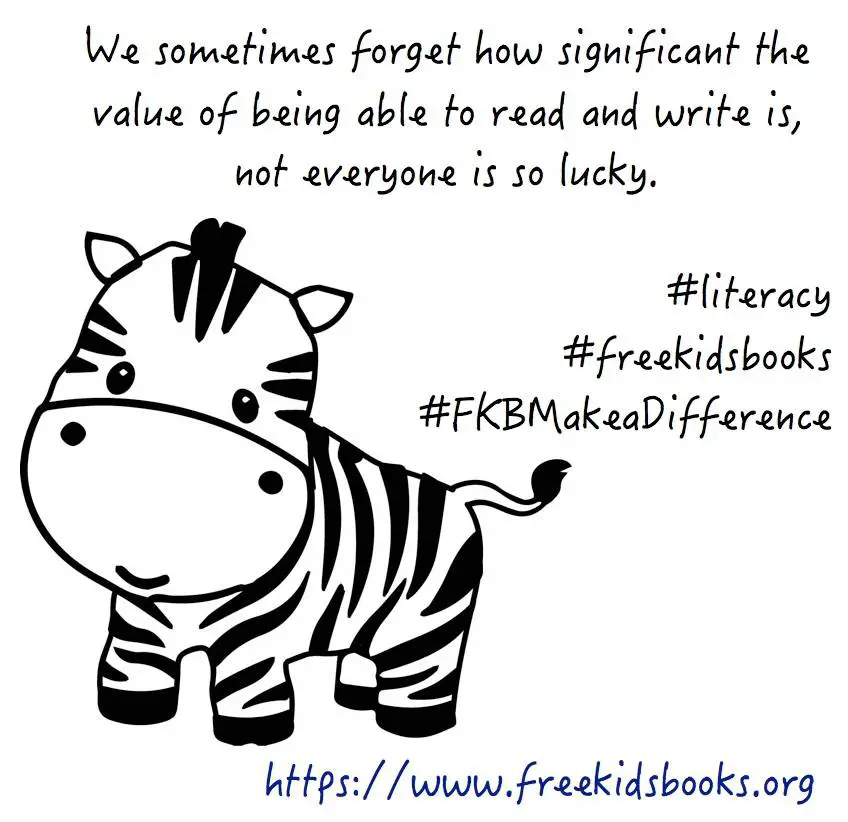
Popular This Month
- Grade 1 Workbooks
- Grade 6 Textbooks
- Grade 4 Textbooks
- Grade 7 Textbooks
- Grade 2 Workbooks

Subscribe to FKB Newsletter
Email address:
What's New

Snowy Owl – Haiku for older children

Building English Vocabulary with Classic Children’s Stories

Monster’s Day Out

Top 10 Insightful Psychology Parenting Books for Nurturing Child Development

Exploring the Boundless Universe of Your Child’s Favorite Book

Happy Train

Croak – the tale of a frog

How To Illustrate a Children’s Book – 6 Quick Tips

A Day at the Carnival

Supercow IV – In a Minute…
You might also like.
- Our Mission
4 Ways to Support Partnerships With Families
An expert in special education shares strategies for building strong and enduring relationships with students’ families that every teacher can use.

The ways in which U.S. education agencies and personnel work and engage with families are constantly evolving, in both concept and practice. Increasingly, those relationships are shifting to a partnership model, in which families and professionals collaborate throughout the course of a child’s education.
There has always been an expectation that family engagement in education is primarily coordinated by the educational leadership in state agencies, districts, schools, and classrooms, causing teachers and administrators at every level to ask, “How do we do this?” In 2011, I worked as the primary writer for WestEd, a research, development, and service agency, to assist the California Department of Education on the initial publication of the Family Engagement Framework: A Tool for California School Districts. The general education community was moving from “parental involvement,” which at the time seemed to describe and promote primarily one-way communication (from educators to families) and supportive volunteering (parents in classrooms and on school sites), to terms and practices intended to broaden interactions to include intentional information exchange, purposeful interaction, and meaningful participation—remember Beyond the Bake Sale: The Essential Guide to Family-School Partnerships ?
For those of us associated with special education, this approach was and is nothing new. So, the answer to “How do we do this?” is one we can help provide. After all, the Individuals with Disabilities Education Act (IDEA) requires parental involvement at every level of implementation—from consent and participation in planning for an individual child through parent representation on local- and state-level advisory groups that provide input to lead agencies on fiscal and policy matters and system improvement. IDEA even requires and provides funding for parent centers, operated by parent organizations with a majority of board members who are parents of children with disabilities, to provide training and information to families and assist with dispute resolution.
Navigating the complex landscape of family–professional partnerships in education is crucial. As the parent of an individual with disabilities and as a special education professional, I recommend four actions to support parents and professionals in working together effectively.
What Educators and Parents Can Do
1. Intentionally prepare for partnership. First, know that no one has been intentionally and adequately prepared for these kinds of partnerships. Teacher, service provider, and administrator preparation programs may provide information about involvement requirements and resources under initiatives like the IDEA and Every Student Succeeds Act (ESSA), but rarely will a pre-service program offer practice or experience in family–professional engagement. Likewise, most families don’t anticipate or have the knowledge and skills needed to engage in the active educational activities of their children, unless they are themselves educators.
New partners, both parents and educators, can access these useful resources for tools and inspiration:
- “Leading by Convening” provides both a framework for state, district, and school leaders engaging stakeholders, broadly, and training modules and tools for implementing engagement activities. This resource is available on the resource library of the National Center for Systemic Improvement (NCSI) site. (Enter “leading” in the keyword search bar.)
- Serving on Groups offers a guidebook and training modules for parents who want to engage.
2. Embrace mutual competence. Essentially, this means that the knowledge and experience of all partners are recognized and valued equally. While professionals hold subject matter expertise and mastery of educational systems and processes, families bring child- and community-specific expertise and have experienced the real-life impacts of educational systems and processes.
The mutual competence ideal is illustrated nicely in the below two resources developed by the NCSI, both of which acknowledge the wisdom and values of both families and professionals when weighing research and other evidence related to important decisions.
- “ Three Circles of Evidence-Based Decision Making in Early Childhood ” presents information using terminology that is more familiar to pre-K and early elementary school parents and professionals.
- “Three Circles of Evidence-Based Decision Making to Support Students with Disabilities” presents information using terminology that is more familiar to parents of and professionals working with K–12 students. This is available in the NCSI resource library (linked in the “Leading by Convening” section above this section) by entering “3 circles” into the keyword search bar.
3. Assume good intention. Adapting this concept from a much-respected parent-professional mentor, Victor Bernstein , I urge potential partners to recognize the following:
- Both families and professionals want what they believe is best for the children.
- Both families and professionals can see what works and what doesn’t... usually on their own... but almost always with support.
- Given the opportunity to really see (i.e., to realize–“real eyes”), both families and professionals will choose what is best.
4. Mindfully transition partnership and responsibility to the next generation. The family will continue to be a significant influence for years to come, because our children matter to us . Although family engagement in education tends to trend downward in middle school and high school years, the family–professional partnership at this stage may serve as a launching point for middle-school- and high school-aged youth to navigate the later years of their educational careers independently.
When youth observe family members, teachers, and administrators engaged in respectful, supportive partnerships on their behalf, they begin to learn the communication and collaboration skills for building trust, promoting understanding, and working together to identify and address challenges. These groups can mindfully act in the following ways.
- Education professionals can recognize and respect the family’s role and struggles and support them as they cede responsibility to their maturing child.
- Families can support mutual understanding and shared decision-making between education professionals and youth, filling in information gaps that naturally exist for each. Professionals are getting to know evolving youth; youth are increasing their participation in unfamiliar systems and processes.
- Families and professionals together can support young adults to navigate their emerging independence by staying engaged, maintaining communication, and serving as neutral but supportive guides.
Raising and educating children and youth are challenging and rewarding undertakings. Families and professionals both experience hurdles and contribute significantly. Finding and collaborating with partners along the way is essential, as children thrive when the adults in their lives can genuinely work together.
What are the strategies you've found effective in building strong family-professional partnerships? Share your experiences in the comments.

How Parents’ Stress Can Hurt Kids
New research finds a link between parental stress and later self-harm in children..
Posted April 8, 2024 | Reviewed by Devon Frye
- What Is Self-Harm?
- Find counselling near me
- New research finds a link between parents’ level of stress when the child was age 6 and later self-harm.
- The parent-child relationship remains crucially important in the healthy development of children.
- Your stress, even when your child is young, could influence the parent-child relationship in negative ways.
- It's important for parents to recognize and manage their stress, for their own benefit and their child's.
I’ve always disliked the common saying, “Big kids, big problems; little kids, little problems,” for a few reasons.
First, it invalidates or dismisses the concerns and questions of parents who are in the throes of raising little kids. It sends an unhelpful signal: “If you think this is hard, wait to see what things will be like when you have teenagers!”
Second, it implies there is no connection between how we deal with the “little problems” of little kids and how this may influence the types of issues these children face when they are older. It reduces childrearing to a series of sequential stages that are not necessarily connected to each other when, in reality, child development is much more nuanced than that.
Third, it lacks empathy and diminishes how excruciatingly vulnerable the brains of little kids are to psychological adversity. What an adult may view as a “little problem” might not feel little to the kid experiencing it.
Finally, it seems to imply the problem lies within the kid, thus downplaying the power parents and caregivers hold in creating, exacerbating, or resolving these problems via their own attitudes, behaviors, and ways of coping.
Why It’s Important to Pay Attention to Young Children’s Problems
A recent European study challenges many of the issues raised by this problematic saying. The research aimed to identify what factors predicted non- suicidal self-injury (NSSI) in adolescence by studying a group of 759 children, over time, starting from age 6, then age 12 and age 16.
Non suicidal self-injury is defined as the deliberate destruction of one’s body tissue e.g. via cutting or burning without suicidal intent. Self-injury, in these situations, is viewed as an unhealthy way to cope with psychological pain and stress that releases tension and eventually restores a sense of calm. Rates of NSSI increase sharply in adolescence; it is typically more common among girls than boys.

The researchers hypothesized that parents’ level of stress earlier in the child’s life would be one of the factors predicting NSSI in adolescence. They measured this stress using the parenting stress index , a validated self-report tool that assesses the magnitude of stress in the parent-child relationship in three key areas: characteristics of the child (e.g. demandingness, hyperactivity); characteristics of the parent (e.g. health, attachment , and competence); and general stress (e.g. financial, social isolation ).
One of the most salient findings from the study was a link between the parents’ level of stress when the child was 6 years old and NSSI, in the same child, in subsequent adolescence.
The results of this study suggest that parental stress plays a role in increasing the risk of NSSI, whereas child-specific factors and exposure to negative events (e.g. the death of a close adult, serious vehicular accident, burn incidents, near-drowning incidents) did not. These findings hint at the uniquely powerful influence parents, and the quality of the parent-child relationship, exert in the healthy psychological development of children.
What Parents Can Do Now
The parent-child relationship remains a crucially important determinant in the healthy development of children—even though parenting , in today’s world, can sometimes feel disempowering and make us feel as though this is not the case.
Your own stress, even when your child is young, could influence the parent-child relationship in negative ways, leading to further complications for both later. If you are a new parent, it is vital to ensure you have the support you need as soon as possible. Possible action steps include:
1. Start early. When it comes to stress and parenting, think of your unique points of vulnerability as early as possible in your parenting journey. For example: are you a single parent? Does your child have special needs? Did you experience adversity in childhood? How might your relationship with your own parents influence your parenting style? In good ways? In not-so-good ways? Who are the people in your life you can turn to when you’re feeling stressed or overwhelmed? Are there other major sources of stress such as your finances, work, or a personal illness that you are dealing with?

Recognizing these areas will heighten your awareness of them and that in itself can help minimize negative repercussions. Furthermore, identifying them early allows an opportunity for proactively safeguarding against how these factors may negatively impact your ability to parent.
2. Be a role model to your child for how to proactively deal with stress in healthy ways. Aim to eliminate unhealthy ways of coping with stress in your own life.
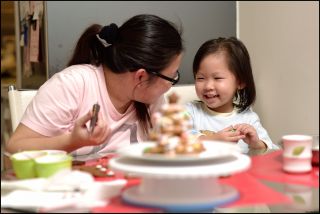
3. Be kind to yourself. Perfection is overrated when it comes to parenting. Strive for a consistently healthy dynamic that is sustainable over time. Allow room for growth and learning for when things do not go as planned. In tough times, always remain compassionate to yourself and your child.
4. Be consistent. Even 30 minutes per day of stress-free bonding and playfulness (e.g. dinner time, bath time, and bedtime reading routines) with your child can do so much to protect the quality of your relationship. Ensure you are present in those moments and free of distractions.
5. Seek professional help. If you’re not getting the traction you need, feel consistently overwhelmed, or have concerns your child is struggling, it’s OK to ask for help. Find a therapist near you in the Psychology Today Therapy Directory.

Shaili Jain, M.D., is an Adjunct Clinical Professor of Psychiatry and Behavioral Sciences at the Stanford University School of Medicine.
- Find a Therapist
- Find a Treatment Center
- Find a Support Group
- International
- New Zealand
- South Africa
- Switzerland
- Asperger's
- Bipolar Disorder
- Chronic Pain
- Eating Disorders
- Passive Aggression
- Personality
- Goal Setting
- Positive Psychology
- Stopping Smoking
- Low Sexual Desire
- Relationships
- Child Development
- Therapy Center NEW
- Diagnosis Dictionary
- Types of Therapy

Understanding what emotional intelligence looks like and the steps needed to improve it could light a path to a more emotionally adept world.
- Coronavirus Disease 2019
- Affective Forecasting
- Neuroscience
- Share full article
Advertisement
Supported by
Guest Essay
Anxious Parents Are the Ones Who Need Help

By Mathilde Ross
Dr. Ross is a senior staff psychiatrist at Boston University Health Services.
This month, across the country, a new cohort of students is being accepted into colleges. And if recent trends continue, the start of the school year will kick off another record-breaking season for anxiety on campus.
I’m talking about the parents. The kids are mostly fine.
Let me explain. Most emotions, even unpleasant ones, are normal. But the word is out about increasing rates of mental health problems on campus, and that’s got parents worrying. Fair enough. The statistics are startling — in 2022, nearly 14 percent of 18-to-25-year-olds reported having serious thoughts about suicide.
But parents are allowing their anxiety to take over, and it’s not helping anyone, least of all their children. If a child calls home too much, there must be a crisis! And if a child calls too little, there must be a crisis! Either way, the panicked parent picks up the phone and calls the college counseling center to talk to someone like me.
I am a psychiatrist who has worked at a major university’s mental health clinic for 16 years. Much of next year’s freshman class was born the year before I started working here. Technically, my job is to keep my door open and help students through crises, big and small. But I have also developed a comprehensive approach to the assessment and treatment of anxious parents.
The typical call from a parent begins like this: “I think my son/daughter is suffering from anxiety.” My typical reply is: “Anxiety in this setting is usually normal, because major life transitions like living away from home for the first time are commonly associated with elevated anxiety.” Parents used to be satisfied with this kind of answer, thanked me, hung up, called their children and encouraged them to think long-term: “This too shall pass.” And most everyone carried on.
But these days this kind of thinking just convinces parents that I don’t know what I’m talking about. In the circular logic of mental health awareness, a clinician’s reassurance that situational anxiety is most likely normal and time-limited leads a parent to believe that the clinician may be missing a serious mental health condition.
Today’s parents are suffering from anxiety about anxiety, which is actually much more serious than anxiety. It’s self-fulfilling and not easily soothed by logic or evidence, such as the knowledge that most everyone adjusts to college just fine.
Anxiety about anxiety has gotten so bad that some parents actually worry if their student isn’t anxious. This puts a lot of pressure on unanxious students — it creates anxiety about anxiety about anxiety. (This happens all the time. Well-meaning parents tell their kid to make an appointment with our office to make sure their adjustment to college is going OK.) If the student says she’s fine, the parents worry that she isn’t being forthright. This is the conundrum of anxiety about anxiety — there’s really no easy way to combat it.
But I do have some advice for parents. The first thing I’d like to say, and I mean it in the kindest possible way, is: Get a grip.
As for your kids, I would like to help you with some age-appropriate remedies. If your child calls during the first weeks of college feeling anxious, consider saying any of the following: You’ll get through this; this is normal; we’ll laugh about this phone call at Thanksgiving. Or, say anything that was helpful to you the last time you started something new. Alternatively, you could say nothing. Just listening really helps. It’s the entire basis of my profession.
If the anxiety is connected to academic performance — for instance, if your child is having difficulty following the professor and thinks everyone in class is smarter — consider saying, “Do the reading.” Several times a semester, a student I’ve counseled tells me he or she discovered the secret to college: Show up for class prepared! This is often whispered rather sheepishly, even though my office is private.
Anxiety about oral presentations is also quite common. You know what I tell students? “Rehearse your speech.” Parents, you can say things like this, too. Practice it: “Son, you wouldn’t believe how helpful practice is.”
I can prepare you for advanced topics, too. Let’s say your child is exhausted and having trouble waking up for class; he thinks he has a medical problem or maybe a sleep disorder. Consider telling him to go to bed earlier. Common sense is still allowed.
What if a roommate is too loud or too quiet, too messy or too neat? Advise your kid to talk to the roommate, to take the conversation to the problem’s source.
If your child is worrying about something more serious, like failing out of college: This is quite common in the first few weeks on campus. Truth be told, failing all of one’s classes and being expelled as a result, all within the first semester, is essentially impossible and is particularly rare among those students who are worrying about it. The administrative process simply doesn’t happen that fast. Besides, you haven’t paid enough tuition yet.
I’m making my job sound easy, and it’s not. I’m making kids sound simple, and they’re not. They are my life’s work. Some kids walk through my door in serious pain. But most don’t. Most just need a responsible adult to show them the way. And most of what I do can be handled by any adult who has been through a thing or two, which is to say, any parent.
I worry that the current obsession with mental health awareness is disempowering parents from helping their adult children handle ordinary things. People are increasingly fearful that any normal emotion is a sign of something serious. But if you send your adult children to a mental health professional at the first sign of distress, you deprive yourself of the opportunity to strengthen your relationship with them. This is the beginning of their adult relationship with you. Show them the way.
The transition to college is full of excitement and its cousin, anxiety. I enjoy shepherding young people through this rite of passage. Parents should try enjoying it, too.
Mathilde Ross is a senior staff psychiatrist at Boston University Health Services.
The Times is committed to publishing a diversity of letters to the editor. We’d like to hear what you think about this or any of our articles. Here are some tips . And here’s our email: [email protected] .
Follow The New York Times Opinion section on Facebook , Instagram , TikTok , WhatsApp , X and Threads .
- International edition
- Australia edition
- Europe edition

Should my partner and I share our love letters from previous relationships with our children?
These missives are an opportunity for connection. If your children don’t want them, that’s up to them, but give them the choice Every week Annalisa Barbieri addresses a family-related problem sent in by a reader
We are in our mid -80s and have been together for 12 years.
Our relationship journeys to our meeting point were utterly different. My partner has two marriages behind her a s well as a long-term partner. Mine was a marriage of over 40 years . My partner and I were colleagues for many years before our retirements.
The issue/opportunity is that we have, between us, at least a shoebox full of love letters from our various relationships. One of mine was from a teenage crush in the late 1950 s and with whom I still have the occasional chat.
So what to do with them?
Should our children be the recipients? Should they be burned? Maybe they could provide some insight into “that crazy little thing called love”! Or could they be a valuable source of information for a writer/researcher ?
I wouldn’t destroy them. Letters are a rich source of both family and social history and remind us how we felt. I don’t know what your letters contain, but a local museum might also be interested. Sometimes, seemingly domestic details can be fascinating as a historical document. I’m very glad that, in my teenage letters, I documented what I wore, the weather, how much things cost and what I spent. At the time a little boring, perhaps, but now a fascinating insight into the past (at least, for me).
I went to psychotherapist Alison Roy with your question. Roy does a lot of work with “family stories”, as much of her work is in the adoption field. While this isn’t relevant to your situation, I was interested in her take on what to do. The first thing Roy wanted to check is if you are both singing from the same hymn sheet – ie, are you both comfortable with each other’s stories? That would be good to check.
“I think it’s important you go through them together to make sure there’s nothing in there you don’t want the children to see,” says Roy. “If what’s in them is indeed comfortable and there’s no fear or anxiety, then you need to think, individually and together, about how important they are in terms of how their stories are told.”
Unless you’ve read the letters very recently, this is an exercise worth doing together, to make sure there are no family secrets or even seemingly “little” details that might cause a big impact that the family doesn’t already know.
There could be things that might not be obviously impactful if you already know about them. So if you have a friend you trust, they could read them for you, seeing what questions are thrown up.
Did any relationships overlap, for instance? Was there anything that might raise eyebrows? I don’t say this in a moralistic way, but these things might need more context – context is key in family history.
As Roy explains, when we go to art galleries, what gives the pictures we see their stories is often the notes alongside the art. She suggested you might want to consider writing “your own little letter about your love letters, your story, and why these letters are important, why you’ve decided to keep them. In other words, a love letter to the people you are still connected to, a letter that completes the cycle.”
It can feel quite understandably excluding to read letters between your parents, or between them and other people, so this idea of Roy’s is a lovely way to include them, and “it gives them permission to be part of it and enjoy it, rather than feeling voyeuristic”.
If you had any photographs that completed the picture it would be great to annotate them, maybe even make a scrapbook. This is a lovely gift to pass on. So much is taken for granted with family history and so much is lost when key members aren’t there any more. Roy also suggested making a “notebook for each child” where you might want to put memories for them to read.
I think these letters are a great opportunity for connection and storytelling, and if your children don’t want to keep them when the time comes then that’s up to them. But give them the opportunity.
Every week, Annalisa Barbieri addresses a personal problem sent in by a reader. If you would like advice from Annalisa, please send your problem to [email protected] . Annalisa regrets she cannot enter into personal correspondence. Submissions are subject to our terms and conditions .
Comments on this piece are premoderated to ensure the discussion remains on the topics raised by the article. Please be aware that there may be a short delay in comments appearing on the site.
- Relationships
- Ask Annalisa Barbieri
- Parents and parenting
Comments (…)
Most viewed.
From the kitchen to the laundry room, 5 home upgrades you didn't know you needed — from $8
- TODAY Plaza
- Share this —

- Watch Full Episodes
- Read With Jenna
- Inspirational
- Relationships
- TODAY Table
- Newsletters
- Start TODAY
- Shop TODAY Awards
- Citi Music Series
- Listen All Day
Follow today
More Brands
- On The Show
NBA star Dennis Rodman has an Olympian as a daughter

NBA legend Dennis Rodman isn't the only athlete in his family.
His soccer-playing daughter, Trinity Rodman , will be kicking it in Paris, France, this summer with the U.S. women's national team .
Trinity is a forward, which is a star-making spot on the USWNT. The position has made Megan Rapinoe and Alex Morgan global stars. She was only 18 when she was the No. 2 overall pick in the draft, which at the time was the record for the youngest NWSL player ever drafted.
After joining the Washington Spirit soccer team in 2021, Trinity was named the NWSL Rookie of the Year. In 2022, she was nominated for the Ballon d’Or Féminin in 2022, recognizing the best players in women’s soccer around the world. In 2023, she became the youngest player in NWSL history to record 10 assists and 10 goals in a regular season career and the youngest player in Spirit history to make 50 appearances with the team.
“She’s an all-out competitor,” former Spirit head coach Kris Ward told ESPN . “Her ability to withstand pressure and close contact with the opponent and her desire to help her team succeed — she’s a change-the-game player. There hasn’t been anyone like her before.”Though Trinity appears to be a bit more subdued than her flamboyant father, she still has that distinctive Rodman flair.
Rodman, who was estranged for years from his own father, has spoken about wanting to be a better dad to his three children.
“The only major, major demon I have right now is trying to convince myself that I am a good dad,” he told ESPN in 2019. “It’s very hard for me to try to break out of that cycle.”
Keep reading to learn more about Dennis Rodman’s three children.
Alexis Rodman
Dennis Rodman and his first wife, Annie Bakes, were only married for 82 days, but the pair welcomed daughter Alexis Rodman into the world on September 28, 1988.
Alexis married Robert Bunfill in 2014 and gave birth to a son named Vincent, making Dennis a grandfather.
He expressed his joy on a post on X in 2017, writing, "Wow, congrats to my daughter Alexis and her husband for the birth of their 1st baby: Vincent! I can’t believe I’m a Grandfather!"
Dennis “D.J.” Rodman Jr.
Dennis was married briefly to second wife, model Carmen Electra, before having a son and a daughter with his third wife, Michelle Moyer.
Dennis "D.J." Rodman Jr. was born on April 25, 2001, and he has been following his dad to the basketball court.

D.J. has been playing college basketball, first at Washington State University and then at the University of Southern California.
According to his team website , D.J., a graduate student, is a 6-foot 6-inch, 225 pound forward "who is a tough defender and top-notch three-point shooter."
Like his famous father, D.J. has been repping some popular brands .
Trinity Rodman
Born on May 20, 2002, Trinity is close in age to D.J., and their bond seems to be a strong one.
In this Instagram video, Trinity said, "One of my favorite things to do is watch my brother compete. Seeing him on the court is the best thing ever."
She went on to say about watching her brother play, "It's an emotional roller coaster for me, but I think I'm definitely his biggest hype woman. I'm cheering. I'll yell at the refs, even."
Her bond with her father doesn't seem to be as close.

When Dennis surprised his daughter by attending one of her games with the Washington Spirit, she wrote in an Instagram post , "My dad doesn’t play a big role in my life at all and most people don’t know that, we don’t see eye to eye on many things. I go months if not years without his presence or communication. Being in spotlights has been hard for us, him and me. We don’t have the best relationship, but at the end of the day he’s human I’m human… he’s my dad, and I’m his little girl and that will never change."
Rosie Colosi lives in New Jersey and is a reporter for TODAY Parents. She has bylines in The Atlantic, The Week, MSNBC, and PureWow, and she has written 33 nonfiction children's books for Scholastic, Klutz, and Nat Geo Kids. Once upon a time, she played Mrs. Claus in "The Rockettes' Radio City Christmas Spectacular," but now she mostly sings songs from "Annie" to her two daughters … while they beg her to play Kidz Bop.
- Search Please fill out this field.
- Manage Your Subscription
- Give a Gift Subscription
- Newsletters
- Sweepstakes
Where Are O.J. Simpson’s Kids Now? What to Know About Arnelle, Jason, Sydney and Justin
O.J. Simpson was a father to five children before his death on April 10
Rebecca Aizin is an Editorial Assistant at PEOPLE. She has been working at PEOPLE since 2023. Her work has previously appeared on Elle, HGTV and Backstage.
:max_bytes(150000):strip_icc():format(webp)/rebecca-aizin-author-bio-eede55e470e54ec686eface7e613e410.jpg)
O.J. Simpson was a father of five before his death at the age of 76 .
The former NFL player shared three children, Arnelle, Jason and Aaren, with his first wife, Marguerite Whitley, and welcomed two kids, Sydney and Justin, with his second wife Nicole Brown Simpson . Aaren died a month before her 2nd birthday after drowning in the family swimming pool.
Simpson's family was thrust into the spotlight after the murder of Nicole and her friend Ron Goldman in June 1994. Simpson was detained days later and an 11-month trial commenced that was dubbed "The Trial of the Century" by many legal experts. On Oct. 3, 1995, 100 million people in the U.S. alone watched as Simpson was acquitted on both counts of murder.
On April 10, 2024, Simpson died at 76 years old from cancer. His family announced the news on his X (formerly known as Twitter) account in a statement.
Bei/Shutterstock ; Vinnie Zuffante/Getty
"On April 10th, our father, Orenthal James Simpson, succumbed to his battle with cancer. He was surrounded by his children and grandchildren. During this time of transition, his family asks that you please respect their wishes for privacy and grace," they wrote.
Here’s everything to know about O.J. Simpson’s five children: Sydney, Justin, Arnelle, Jason and Aaren.
Arnelle Simpson, 55
Alexander Tamargo/Getty
Simpson’s eldest daughter was born on Dec. 4, 1968, when the football player was 21 years old. Arnelle testified at his 1994 trial where he was accused of murdering his second wife, Nicole. She claimed that her father was "emotional," "distraught" and "out of control" when he learned of her death, per CNN.
Arnelle remained a vocal supporter of her father, speaking out again during his 2017 parole hearing following his jail sentence for a 2007 armed robbery at a Las Vegas hotel. At the time, she asked that her dad be released so her family could “move forward.”
"As a family, we recognize he's not the perfect man, but as a man and a father he has done his best to behave in a way that speaks to his overall nature and character,” she said, after describing him as her “best friend,” per CBS .
Jason Simpson, 53
Michael Ochs Archives/Getty
Simpson and Whitley’s second child, Jason, was born in 1970. Jason was by his dad’s side during important moments of his career, including when he was inducted into the Buffalo Bills Wall of Fame in Rich Stadium in 1980.
He also attended the premiere of Naked Gun 33 1/3: The Final Insult alongside his father, Nicole and two younger siblings three months before Nicole’s murder.
After the infamous police chase where the authorities were tailing a white Ford Bronco containing Simpson and his friend and former teammate Al Cowlings, Jason met his father at his Brentwood home and tried to speak to him. Jason was handcuffed by the police at the time and led back into the house.
Per the Los Angeles Times , as of 2016, Jason was living a private life as a chef at an Atlanta restaurant, St. Cecilia.
Aaren Simpson
Simpson and Whitley welcomed their third chid, daughter Aaren, in 1977. Just one month shy of her 2nd birthday, Aaren tragically drowned in a pool. Simpson rarely discussed the incident in public.
Sydney Brooke Simpson, 38
Bei/Shutterstock
Sydney, O.J. and Nicole’s first child together, was born on Oct. 17, 1985. She was only 8 years old when her mom died, and was helped raised by her aunt and Nicole’s sister, Tanya Brown, after Nicole’s death.
Sydney and Justin moved to Florida in 2000, six years after their mom’s death, and have lived in relative anonymity since. Sydney graduated from Boston University in 2010 with a degree in sociology and spent time in Atlanta before she moved to St. Petersburg, Florida.
As of April 2016, Sydney works in real estate as an owner of multiple properties in Florida that she oversees, per the Tampa Bay Times .
That same year, in February 2016, Sydney and her brother Justin attended the wedding of their cousin , Sean Brown, who is Nicole’s sister Denise Brown's son, in Newport Coast, California. They were photographed at the ceremony as he wed Laguna Beach ‘s Casey Reinhardt.
Justin Ryan Simpson, 35
DMI/The LIFE Picture Collection/Shutterstock
O.J.’s youngest child, Justin, was born on Aug. 6, 1988. He was 5 years old when his mom was murdered outside the house as he slept.
Like his sister, Justin works in real estate and, as of 2016, was employed by Coldwell Banker. He is an agent based in St. Petersburg, telling the Tampa Bay Times , "It's a great place to live, why not St. Pete? It’s gorgeous here.”
In February 2022, Justin announced on his Instagram that he was expecting a child with his partner, a baby girl they named Lana.
“We are extremely excited, scared, nervous and in love ❤️ ❤️ ❤️,” he captioned the post. “In only a few short months we will be welcoming little Lana and can’t wait for you to meet her!”
Related Articles

IMAGES
VIDEO
COMMENTS
Cite this essay. Download. The relationship between the parents and the child is amongst the most prominent relationships in the life of an individual. Young children depend on their parents to provide them with fundamental needs as well as their parents provide their children with guidance and support to build their future generations.
Another example of the relationship between parents and children is the work Amy Tan's Rules of the Game. This story tells a situation where a girl achieved success in chess, and her mother was so proud of her that she walked down the street and told everyone about her daughter. Every day, the mother taught her daughter and sons various ...
Parent Child Relationship Essay: Loving a child is an exhausting experience, but giving them everything they need will be worth the struggle! Societal norms dictate that adults can improve their relationships with their children through strengthening, acknowledging and supporting each other. A parent-child relationship is unique in that it has ...
Underlying the shift in parent-child relationships are a raft of historic shifts. Delayed parenthood, better educated parents, and reduced birthrates all lead parents to increase their fixation ...
Good Parent-Children Relationship Essay. Relationships are a very important part of human life. Regardless of the success of any human being, relationships are an essential key to a better life and their ignorance could have the most serious repercussions. Family members should strive as much as they can to relate well with each other.
Answer 2: Parents mean different things to different people. To most of us, they are our source of happiness and protection. They are the ones who are the closest to us and understand our needs without having to say them out loud. Similarly, they love us unconditionally for who we are without any ifs and buts.
Parents are responsible for nurturing and shaping their children from infancy to adulthood, providing them with guidance, support, love, and discipline. Children, in turn, look to their parents for love, security, and guidance as they grow and develop. This relationship is often characterized by unconditional love, mutual respect, and a deep ...
The Parent-Child Relationship is one that nurtures the physical, emotional and social development of the child. It is a unique bond that every child and parent will can enjoy and nurture. This relationship lays the foundation for the child's personality, life choices and overall behaviour. It can also affect the strength of their social ...
The strong association between youth well-being and parent-child relationships. is robust across cultures. This conclusion is illustrated by a study of 1,034 early. adolescents (ages 10-14) from ...
When parents complain that their children don't behave, it can be helpful to think about the state of the parent-child relationship. Parenting. 7 Min Read. Parental Wisdom from Decades Past .
The Relationship Between Father and Son. 1 page / 549 words. Parent-child relationships, particularly the bond between fathers and sons, play a crucial role in the development and well-being of individuals. This essay explores the various aspects of the father-son relationship, including its definition, historical perspectives, psychological ...
Of parents and children is the argumentative essay by Francis bacon. In this essay, he argues about the relationship between parents and children along with the pons and cons of having children. This essay by Francis bacon is comparatively short and focused on a subject-matter which cannot be extended a lot, however, it is loaded with meaning.
Parents agreed that children's well-being is mostly depended on family environment. This the role of father in the family essay will explore the role and father's influence through different studies. Parents expressed that family quarrel is very common in our culture. If there is a...
Conflict in the parent-child relationship might occur in several ways related to technology (e.g., through parental attempts to control technology use, negotiations on content). Differences exist in perceived conflict in families by child age (e.g., fewer parents report conflict with children under 8 years), and changes in parent control with ...
Essay Sample: The relationship between parents and their children is perhaps one of the most important relationships among human beings. The relationship between ... Apple's "Bridging" explores the parent-child relationship theme primarily from the angle of having to survive a family tragedy for the rest of their lives. Apparently, the ...
Parent Child Relationships Essay. Better Essays. 1625 Words. 7 Pages. Open Document. The purpose of this paper is to observe the interactions of a parent-child dyad and apply aspects of the theories studied in class to the observation. Since my experience working with families is limited to brief interactions with infant children and their ...
How having conversations with children builds their language — and strengthens family connections. Kimberly Hillier, University of Windsor. Engaging in purposeful, meaningful and strategic ...
Introduction and background. Good parenting is a process whereby a parent meets a child's needs according to the cultural standard that changes from generation to generation [].Research on parent-child relationships and childhood development increased rapidly during this era; the research is mainly based on parenting practices and child development and maturation.
Essay on Parents-Child Relationship. This essay sample was donated by a student to help the academic community. Papers provided by EduBirdie writers usually outdo students' samples. Children are the most important entities not only in the life of parents but also in the life of society and the state to a larger extent.
Essay Samples on Parent-Child Relationship. Essay Examples. Essay Topics. Why Should We Respect Our Parents: Exploring Islamic Arguments ... The mother-daughter relationship is arguably the closest and most important parent-child relationship, particularly with regarding to interactions between generations, communication and interpersonal ...
A baby cries, a parent feeds her; a baby snuggles, a parent hugs her. When distressed, babies turn to the person who satisfies their needs. When babies or even children get hurt they rely on their parents for help. They would cry until safely in their mothers or fathers arms. see more:life in 2050 essay.
Family Relationships. This William Shakespeare play provides numerous examples of the intricate and tumultuous dynamics of parenthood and family relations, making it a rich source of material for essay examples.. The difficulties of parenthood and family ties are one of the main themes. Although Hamlet has great admiration and respect for his father, the king's assassination complicates his ...
An expert in special education shares strategies for building strong and enduring relationships with students' families that every teacher can use. By Angela McGuire. April 10, 2024 ... operated by parent organizations with a majority of board members who are parents of children with disabilities, to provide training and information to ...
Key points. New research finds a link between parents' level of stress when the child was age 6 and later self-harm. The parent-child relationship remains crucially important in the healthy ...
The relationship between parents and children in Romeo and Juliet tends to be quite fraught. In those days, parents were expected to rule their children with a rod of iron and insist on absolute ...
As for your kids, I would like to help you with some age-appropriate remedies. If your child calls during the first weeks of college feeling anxious, consider saying any of the following: You'll ...
Our relationship journeys to our meeting point were utterly different. My partner has two marriages behind her as well as a long-term partner. Mine was a marriage of over 40 years. My partner and ...
All about NBA legend Dennis Rodman's three kids. Son, D.J., plays college basketball while daughter, Trinity, plays soccer for the US women's national team.
Here's everything to know about the model's relationship with her parents. ... In 1993, they welcomed their first child, a daughter they named Alaia. Hailey completed the family when she was ...
O.J. Simpson had three children with his first wife Marguerite Whitley and two with his second wife Nicole Brown. Here's everything to know about O.J. Simpson's five kids.